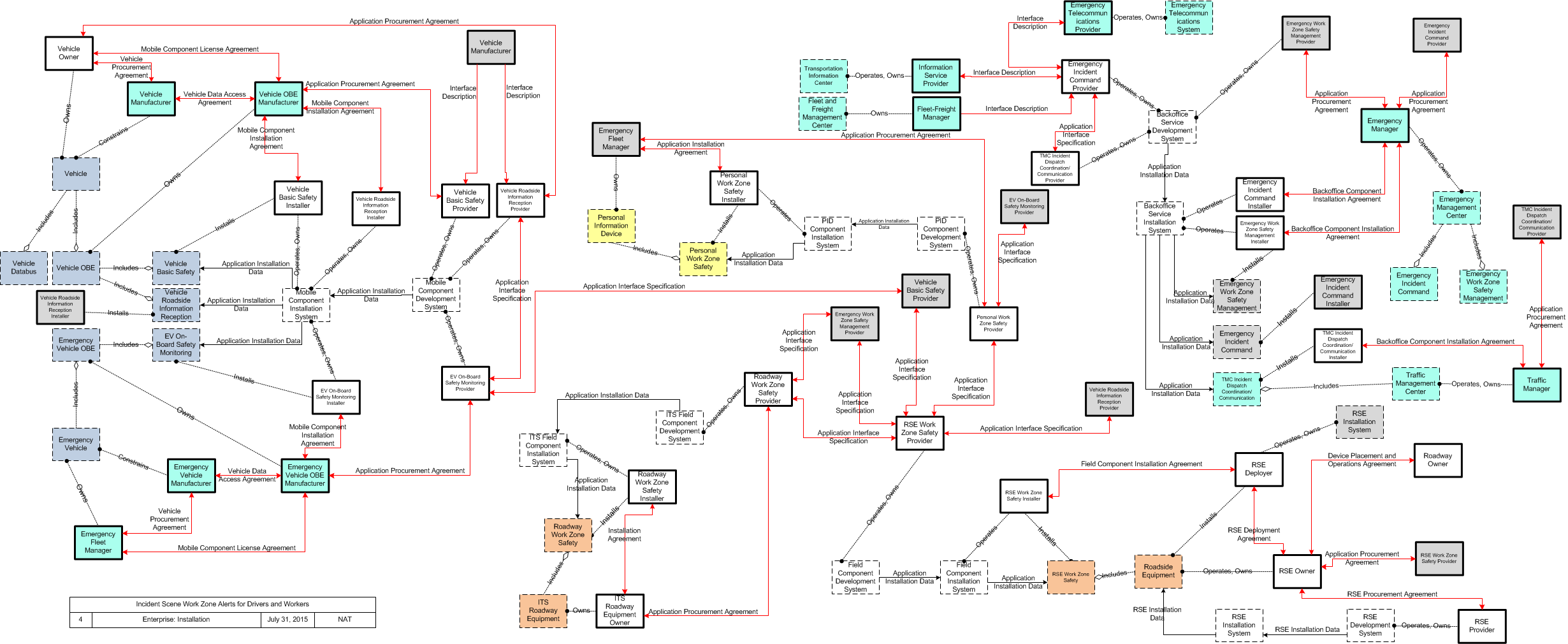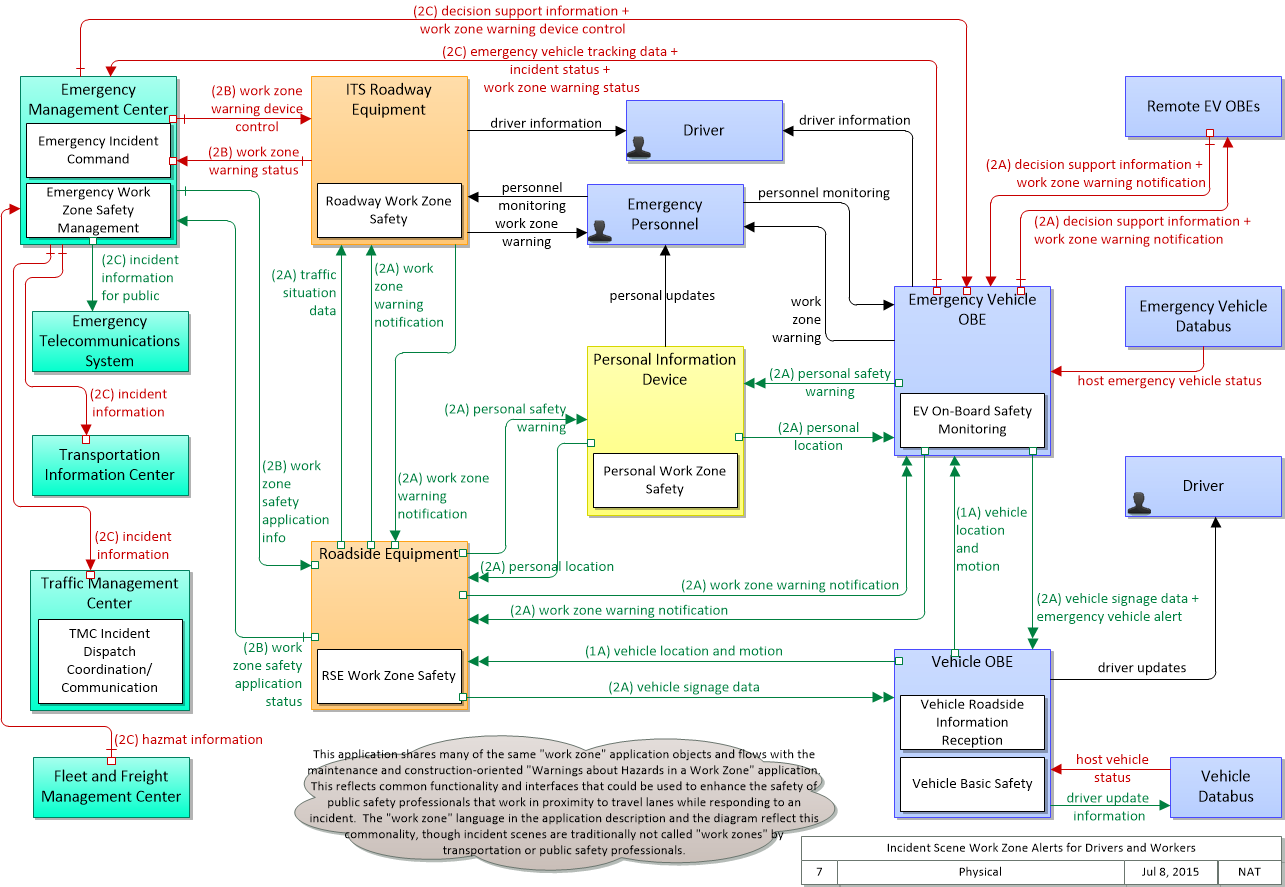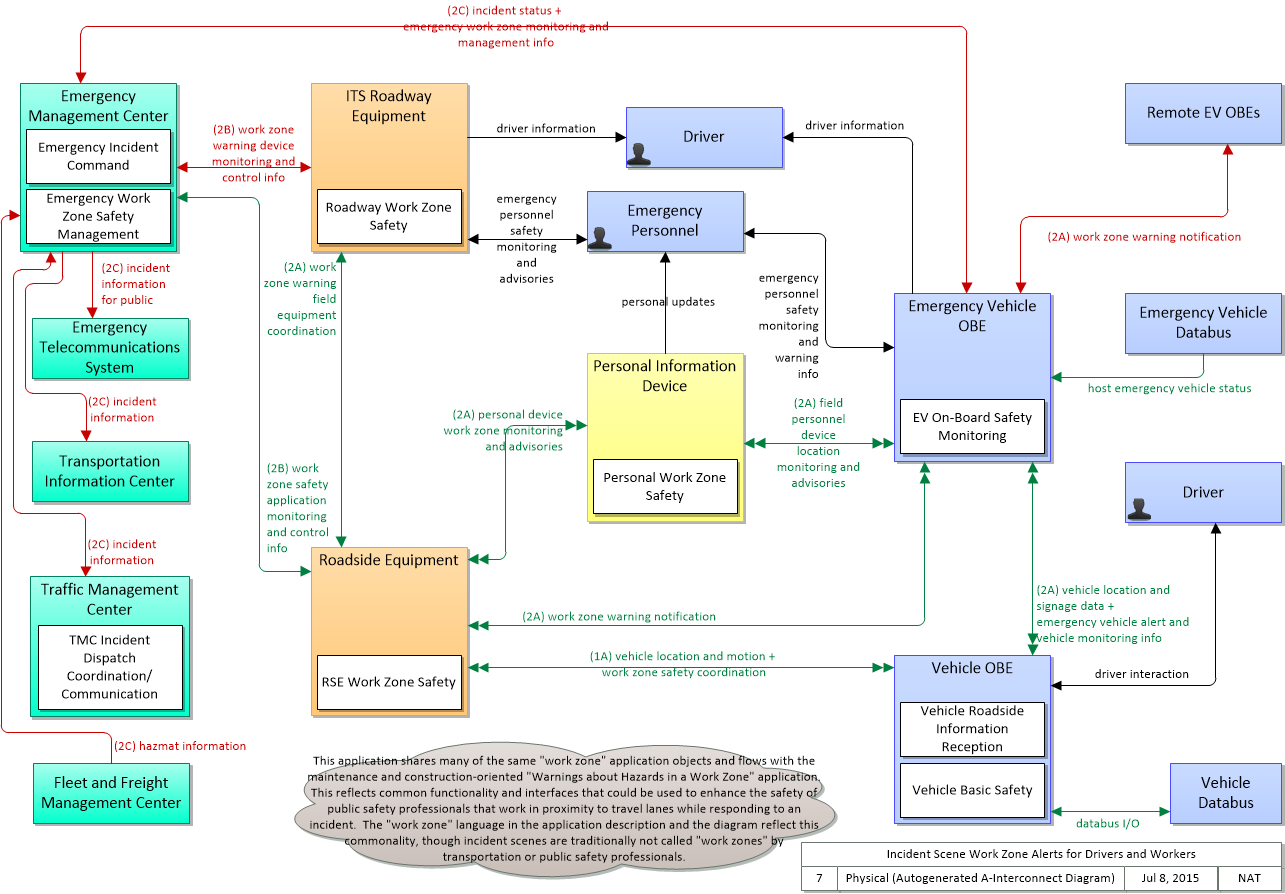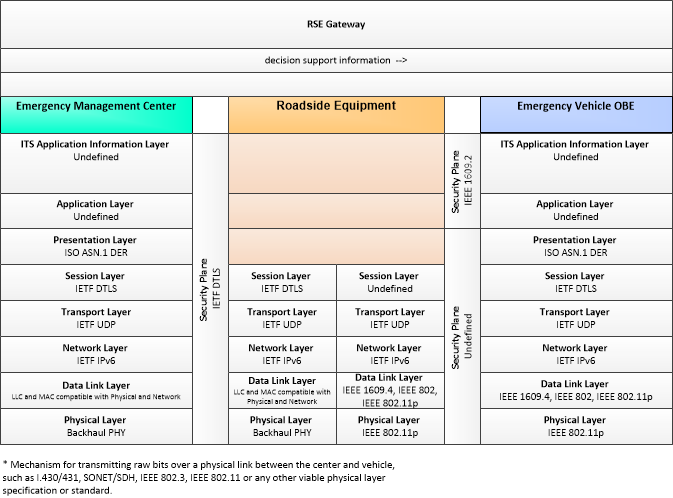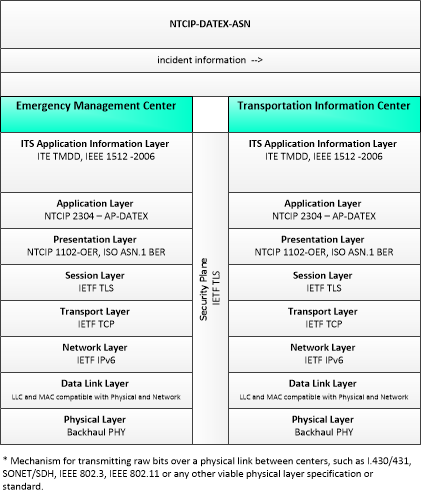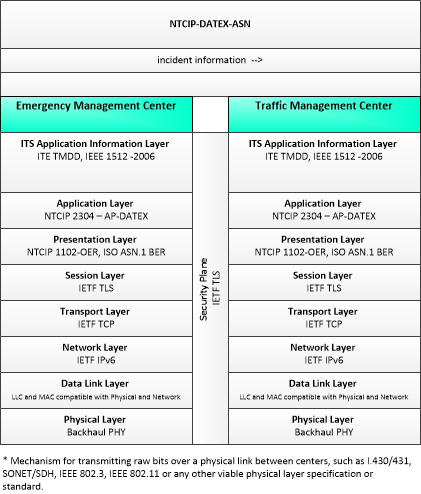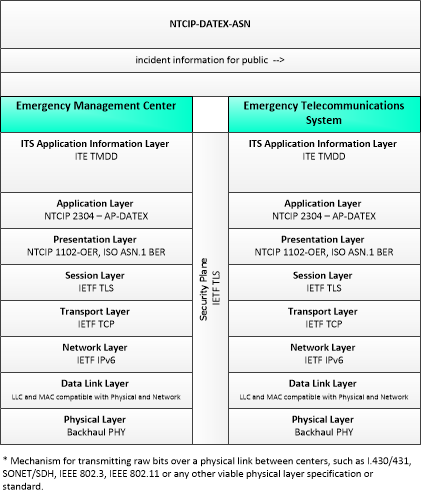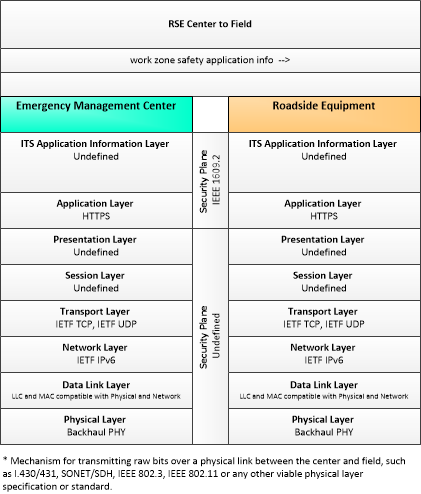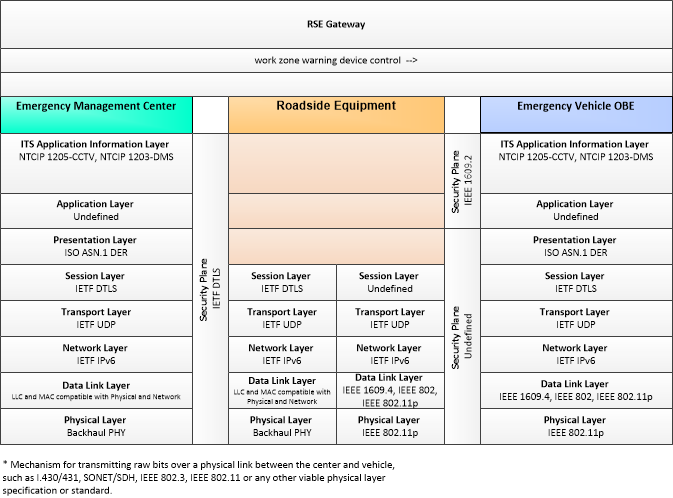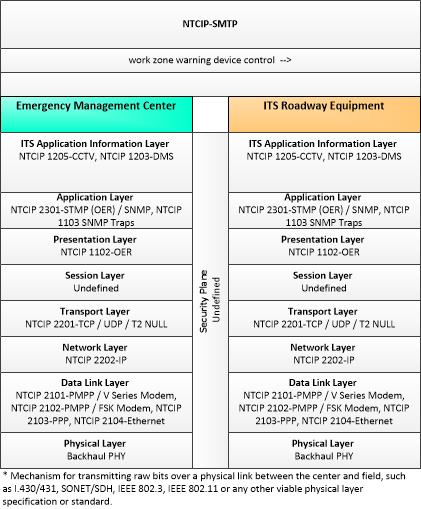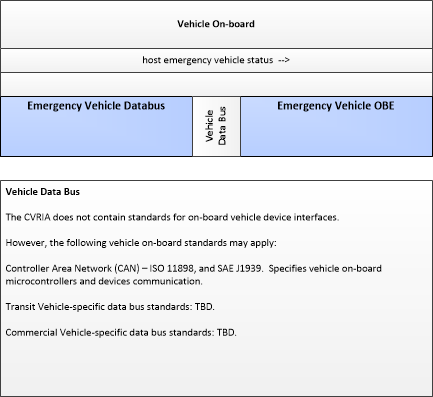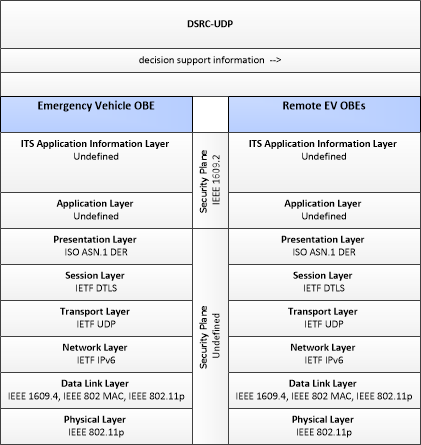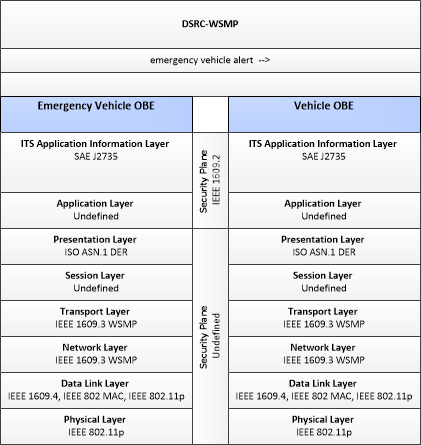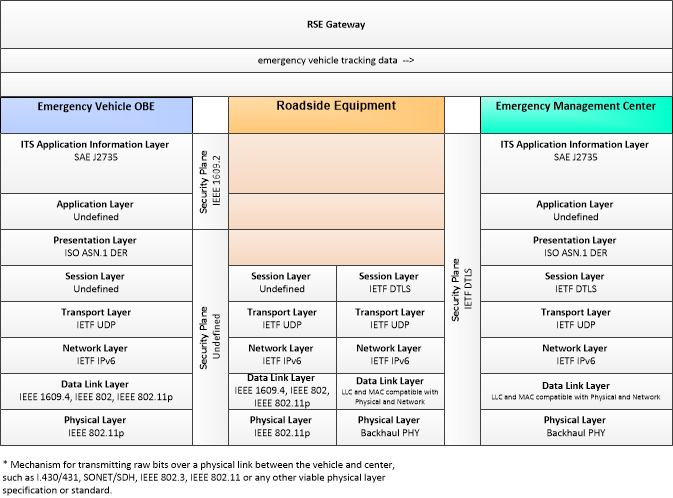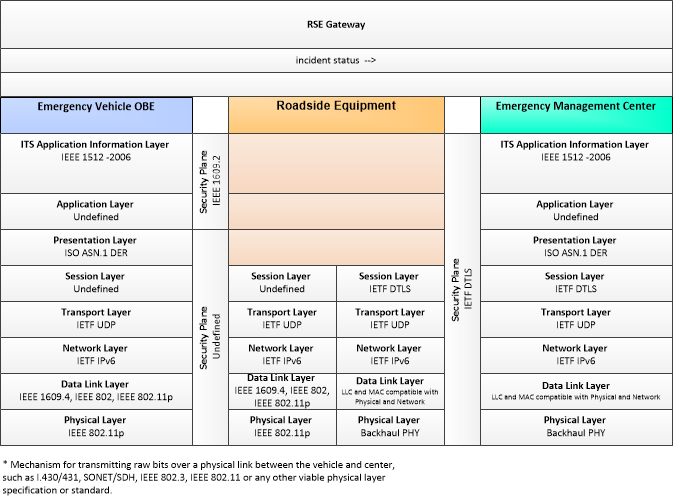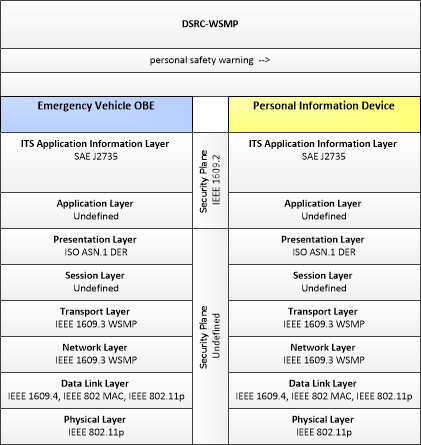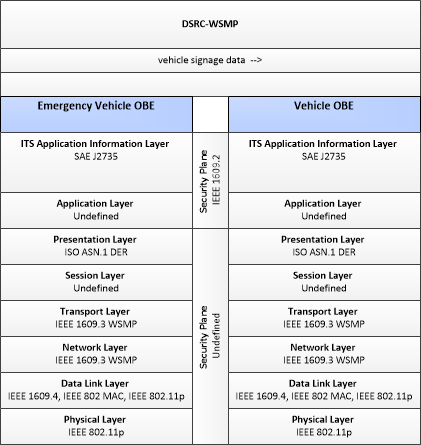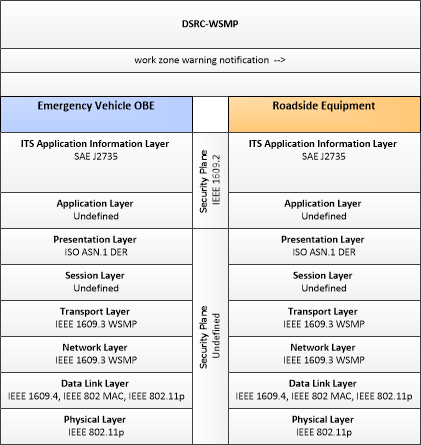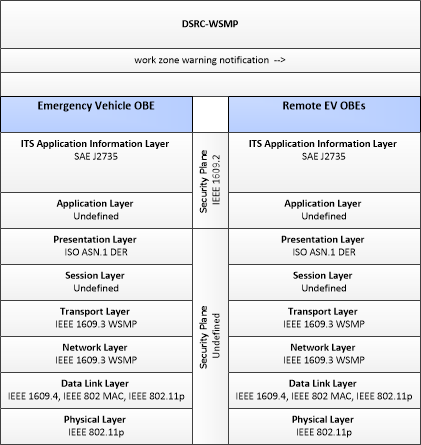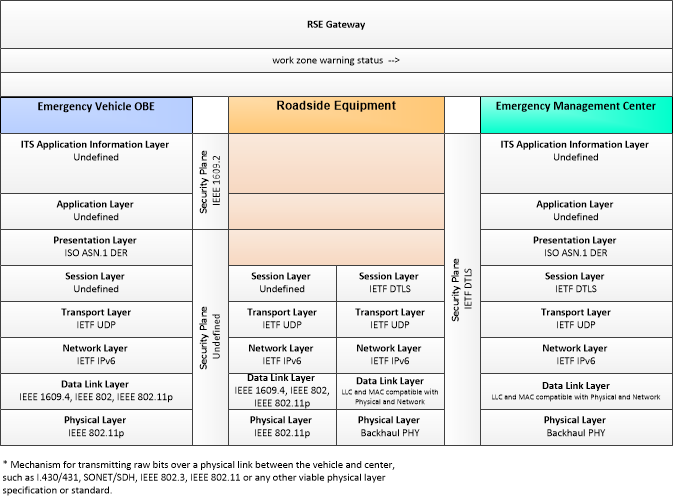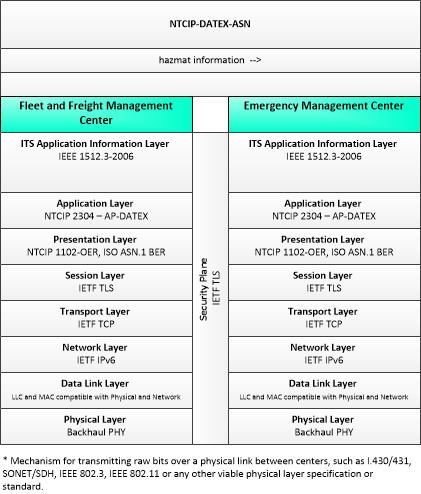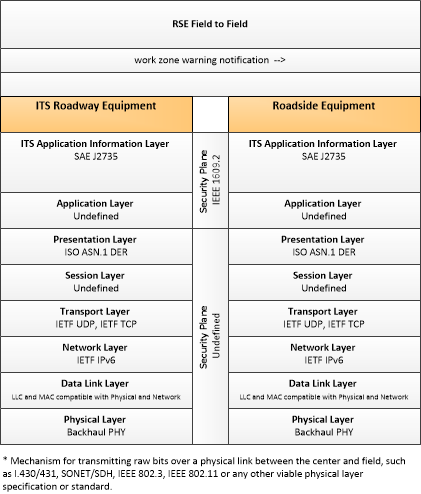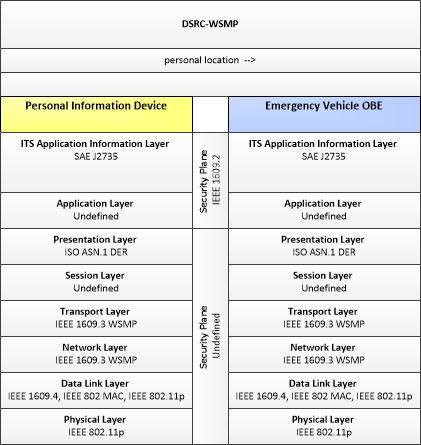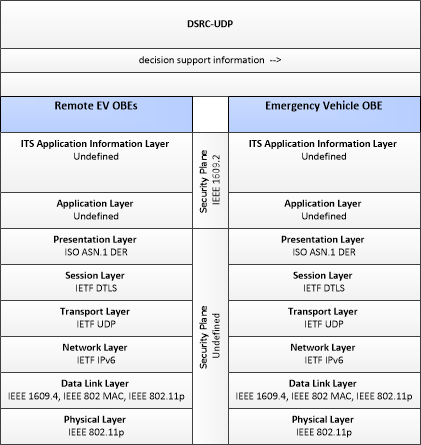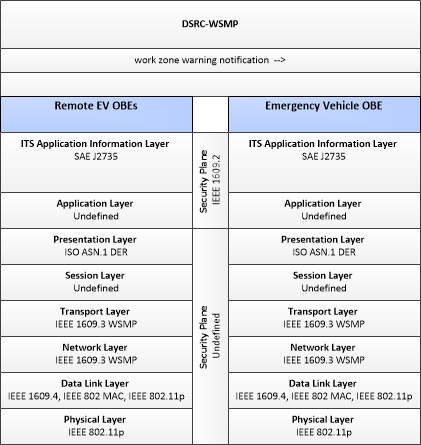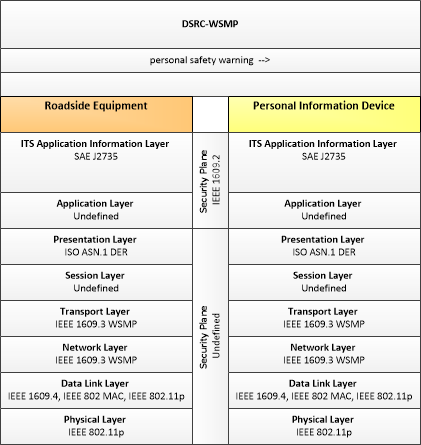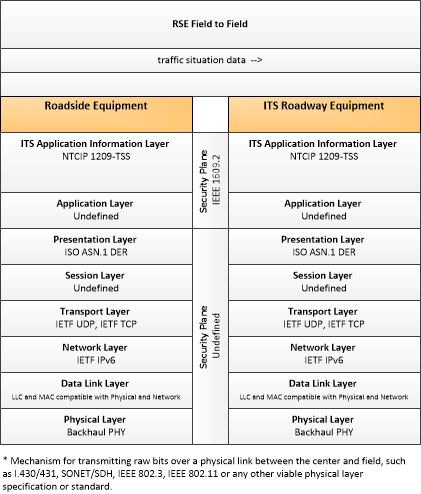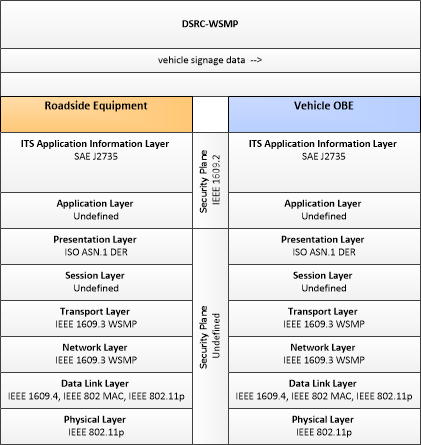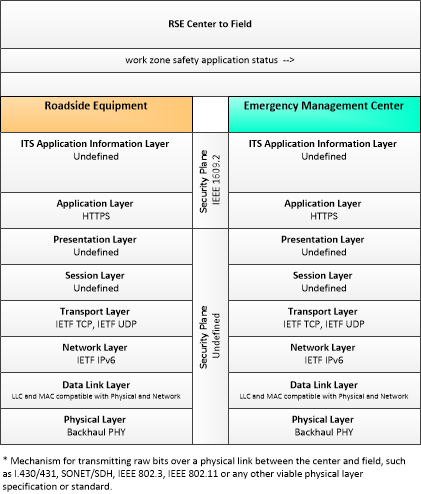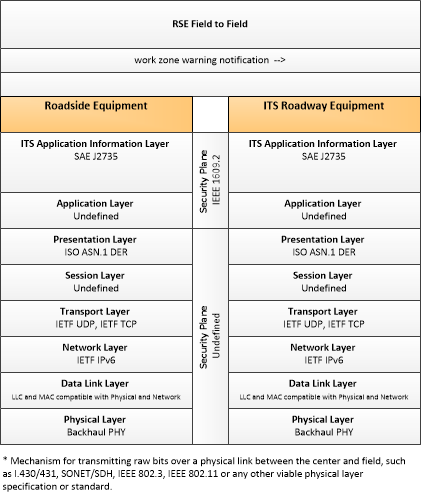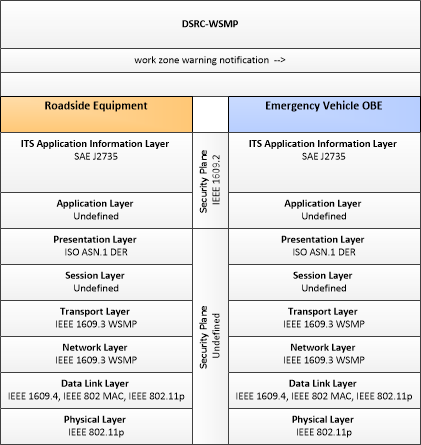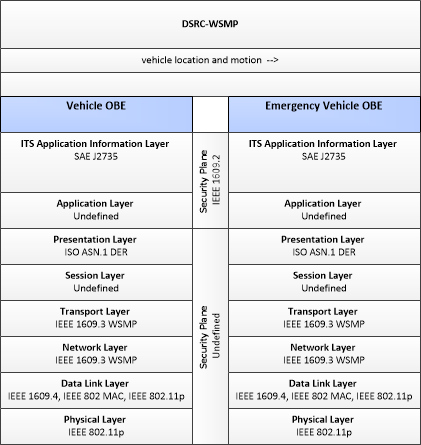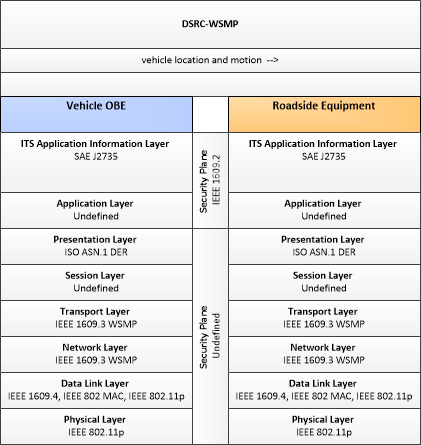Type: Mobility
Groups:- Public Safety
Incident Scene Work Zone Alerts for Drivers and Workers
The Incident Scene Work Zone Alerts for Drivers and Workers (INC-ZONE) application employs communications technologies to provide warnings and alerts relating to incident zone operations. One aspect of the application is an in-vehicle messaging system that provides drivers with merging and speed guidance around an incident. Another aspect is providing in-vehicle incident scene alerts to drivers, both for the protection of the drivers as well as incident zone personnel. A third aspect is an infrastructure based warning system for on-scene workers when a vehicle approaching or in the incident zone is being operated outside of safe parameters for the conditions. Additional information such as arriving and staging of additional responders would also be provided to assist in staging decisions and response to the incident.
Enterprise
SVG Diagrams: Installation Operations Maintenance Certification
PNG Diagrams: Installation Operations Maintenance Certification

Business Interaction Matrix:
| Incident Scene Work Zone Alerts for Drivers and Workers Operations Stage | ||||||||||||||||||||
|---|---|---|---|---|---|---|---|---|---|---|---|---|---|---|---|---|---|---|---|---|
| Vehicle Owner | Driver | Vehicle OBE Owner | Roadway Owner | RSE Owner | RSE Operator | ITS Roadway Equipment Owner | ITS Roadway Operator | Fleet-Freight Manager | Traffic Manager | Information Service Provider | Emergency Fleet Manager | RSE Work Zone Safety Provider | Emergency Manager | Emergency Response Personnel | Emergency Telecommunications Provider | Vehicle Basic Safety Provider | Personal Work Zone Safety Provider | Vehicle Roadside Information Reception Provider | EV On-Board Safety Monitoring Provider | |
| Vehicle Owner | Vehicle Usage Agreement | Vehicle OBE Usage Agreement | Application Usage Agreement | Application Usage Agreement | ||||||||||||||||
| Driver | Vehicle Usage Agreement | Expectation of Information Provision | Expectation of Information Provision | Expectation of Action | ||||||||||||||||
| Vehicle OBE Owner | Vehicle OBE Usage Agreement | Expectation of Information Provision | Expectation of Data Provision | Expectation of Data Provision | ||||||||||||||||
| Roadway Owner | Service Delivery Agreement | |||||||||||||||||||
| RSE Owner | Service Delivery Agreement | Operations Agreement | Information Exchange Agreement | Application Usage Agreement | Information Exchange Agreement | |||||||||||||||
| RSE Operator | Expectation of Data Provision | Operations Agreement | ||||||||||||||||||
| ITS Roadway Equipment Owner | Information Exchange Agreement | Operations Agreement | ||||||||||||||||||
| ITS Roadway Operator | Expectation of Information Provision | Operations Agreement | Expectation of Information Provision | |||||||||||||||||
| Fleet-Freight Manager | Information Provision Agreement | |||||||||||||||||||
| Traffic Manager | Information Exchange Agreement | |||||||||||||||||||
| Information Service Provider | Information Exchange Agreement | |||||||||||||||||||
| Emergency Fleet Manager | Information Exchange Agreement | Vehicle Usage Agreement | Application Usage Agreement | |||||||||||||||||
| RSE Work Zone Safety Provider | Application Usage Agreement | |||||||||||||||||||
| Emergency Manager | Information Exchange Agreement | Information Provision Agreement | Information Exchange Agreement | Information Exchange Agreement | Information Exchange Agreement | Information Exchange Agreement | ||||||||||||||
| Emergency Response Personnel | Expectation of Action | Expectation of Data Provision | Expectation of Information Provision | Vehicle Usage Agreement | Application Usage Agreement | |||||||||||||||
| Emergency Telecommunications Provider | Information Exchange Agreement | |||||||||||||||||||
| Vehicle Basic Safety Provider | Application Usage Agreement | |||||||||||||||||||
| Personal Work Zone Safety Provider | Application Usage Agreement | |||||||||||||||||||
| Vehicle Roadside Information Reception Provider | Application Usage Agreement | |||||||||||||||||||
| EV On-Board Safety Monitoring Provider | Application Usage Agreement | |||||||||||||||||||
Includes Enterprise Objects:
| Enterprise Object | Description |
|---|---|
| Application Certification Entity | The body that determines whether an application may be deployed and operated in the Connected Vehicle Environment. This entity's composition, the requirements it applies and the procedures it uses to verify those requirements may vary with application type. For example, applications with human safety component (crash avoidance, movement assistance etc.) may have stringent requirements and extensive testing in a variety of conditions, while applications that provide strictly mobility functionality may have far less testing requirements; possibly as little as just making sure the application doesn't interfere with any other applications. |
| Device Certification Entity | The body that determines whether a device may be deployed and operated in the Connected Vehicle Environment. This entity's composition, the requirements it applies and the procedures it uses to verify those requirements may vary with device type. |
| Driver | The 'Driver' represents the person that operates a vehicle on the roadway. Included are operators of private, transit, commercial, and emergency vehicles where the interactions are not particular to the type of vehicle (e.g., interactions supporting vehicle safety applications). The Driver originates driver requests and receives driver information that reflects the interactions which might be useful to all drivers, regardless of vehicle classification. Information and interactions which are unique to drivers of a specific vehicle type (e.g., fleet interactions with transit, commercial, or emergency vehicle drivers) are covered by separate objects. |
| Emergency Fleet Manager | The entity that controls emergency vehicles and provides them for use in incident response. |
| Emergency Incident Command Installer | Application Component Installers are specified more by role than by function. Installers are responsible for the installation of the application component, which may require a support system, and may entail agreements and relationships between end users and application providers. |
| Emergency Incident Command Maintainer | Application Component Maintainers are specified more by role than by function. Maintainers are responsible for the maintenance (configuration changes, patches and updates, hardware repairs) of the application component, which may require a support system, and may entail agreements and relationships between end users and application providers. |
| Emergency Incident Command Provider | Application Component Providers are specified more by role than by function. Providers are responsible for the development of the application component, including initial creation, enhancement and bug fixes. Delivery of the application to the end user may require relationships with other entities (installers, maintainers) if the provider chooses not to fulfill those roles. |
| Emergency Manager | The "Emergency Manager" represents agencies charged with incident management, disaster response, and transportation environment security. |
| Emergency Response Personnel | "Emergency Personnel" represents personnel that are responsible for police, fire, emergency medical services, towing, service patrols, and other special response team (e.g., hazardous material clean-up) activities at an incident site. These personnel are associated with the Emergency Vehicle during dispatch to the incident site, but often work independently of the Emergency Vehicle while providing their incident response services. Emergency personnel may include an Officer in Charge (OIC) and a crew. When managing an incident following standard Incident Command System practices, the on-site emergency personnel form an organizational structure under the auspices of an Incident Commander. |
| Emergency Telecommunications Provider | Application Component Providers are specified more by role than by function. Providers are responsible for the development of the application component, including initial creation, enhancement and bug fixes. Delivery of the application to the end user may require relationships with other entities (installers, maintainers) if the provider chooses not to fulfill those roles. |
| Emergency Vehicle Manufacturer | The entity that builds, assembles, verifies and validates the Emergency Vehicle in which the Emergency Vehicle OBE will eventually operate. |
| Emergency Vehicle OBE Manufacturer | The entity that builds, assembles, verifies and validates the Emergency Vehicle OBE. This can be an OEM-equipped OBE, retrofit or aftermarket equipment. |
| Emergency Work Zone Safety Management Installer | Application Component Installers are specified more by role than by function. Installers are responsible for the installation of the application component, which may require a support system, and may entail agreements and relationships between end users and application providers. |
| Emergency Work Zone Safety Management Maintainer | Application Component Maintainers are specified more by role than by function. Maintainers are responsible for the maintenance (configuration changes, patches and updates, hardware repairs) of the application component, which may require a support system, and may entail agreements and relationships between end users and application providers. |
| Emergency Work Zone Safety Management Provider | Application Component Providers are specified more by role than by function. Providers are responsible for the development of the application component, including initial creation, enhancement and bug fixes. Delivery of the application to the end user may require relationships with other entities (installers, maintainers) if the provider chooses not to fulfill those roles. |
| EV On-Board Safety Monitoring Installer | Application Component Installers are specified more by role than by function. Installers are responsible for the installation of the application component, which may require a support system, and may entail agreements and relationships between end users and application providers. |
| EV On-Board Safety Monitoring Maintainer | Application Component Maintainers are specified more by role than by function. Maintainers are responsible for the maintenance (configuration changes, patches and updates, hardware repairs) of the application component, which may require a support system, and may entail agreements and relationships between end users and application providers. |
| EV On-Board Safety Monitoring Provider | Application Component Providers are specified more by role than by function. Providers are responsible for the development of the application component, including initial creation, enhancement and bug fixes. Delivery of the application to the end user may require relationships with other entities (installers, maintainers) if the provider chooses not to fulfill those roles. |
| Federal Regulatory | Federal regulatory bodies that have legal authority to control and/or provide input to policies regulating transportation infrastructure and operations. This includes entities such as the Federal Communications Commission and US Department of Transportation. |
| Fleet-Freight Manager | The 'Fleet-Freight Manager' represents the people that are responsible for the dispatching and management of Commercial Vehicle fleets (e.g. traditional Fleet Managers) and Freight Equipment assets. It may be many people in a large tracking organization or a single person (owner driver) in the case of single vehicle fleets. The Fleet-Freight Manager provides instructions and coordination for Commercial Vehicles and Freight Equipment and receives the status of the vehicles and freight equipment in the fleet that they manage. |
| Information Service Provider | The "Information Service Provider" represents the owner of the Transportation Information Center. The Information Service Provider is responsible for collecting and disseminating information relevant to the traveling public. |
| ITS Certification Entity | The body that determines whether an ITS device or application may be deployed and operated in the transportation environment. This entity's composition, the requirements it applies and the procedures it uses to verify those requirements may vary with device and application type. Typically not a formal body, assigned on a project-by-project basis depending on the type of infrastructure involved. Since ITS projects are locally-focused (typically state or smaller), the entities that are part of this body are typically those with operational jurisdiction where the ITS is installed (e.g., state or local DOTs, state or local maintenance managers etc.) |
| ITS Roadway Equipment Owner | The entity that owns the Roadway ITS equipment. |
| ITS Roadway Operator | The entity that operates the Roadway ITS equipment. |
| Personal Work Zone Safety Installer | Application Component Installers are specified more by role than by function. Installers are responsible for the installation of the application component, which may require a support system, and may entail agreements and relationships between end users and application providers. |
| Personal Work Zone Safety Maintainer | Application Component Maintainers are specified more by role than by function. Maintainers are responsible for the maintenance (configuration changes, patches and updates, hardware repairs) of the application component, which may require a support system, and may entail agreements and relationships between end users and application providers. |
| Personal Work Zone Safety Provider | Application Component Providers are specified more by role than by function. Providers are responsible for the development of the application component, including initial creation, enhancement and bug fixes. Delivery of the application to the end user may require relationships with other entities (installers, maintainers) if the provider chooses not to fulfill those roles. |
| PID Provider | The entity that designs, manufacturers and provides (either to the end user or to a reseller) the personal information device, including its hardware and base operating software. |
| Roadway Owner | The owner of the roadway proximate to which roadside equipment will be/is installed. |
| Roadway Work Zone Safety Installer | Application Component Installers are specified more by role than by function. Installers are responsible for the installation of the application component, which may require a support system, and may entail agreements and relationships between end users and application providers. |
| Roadway Work Zone Safety Maintainer | Application Component Maintainers are specified more by role than by function. Maintainers are responsible for the maintenance (configuration changes, patches and updates, hardware repairs) of the application component, which may require a support system, and may entail agreements and relationships between end users and application providers. |
| Roadway Work Zone Safety Provider | Application Component Providers are specified more by role than by function. Providers are responsible for the development of the application component, including initial creation, enhancement and bug fixes. Delivery of the application to the end user may require relationships with other entities (installers, maintainers) if the provider chooses not to fulfill those roles. |
| RSE Deployer | The entity responsible for the deployment, operations and maintenance of roadside equipment. |
| RSE Operator | The entity that operates roadside equipment in the transportation environment. |
| RSE Owner | The owner of roadside equipment. |
| RSE Provider | The "RSE Provider" is the entity that develops and (presumably) sells roadside equipment to other entities for deployment and research. |
| RSE Work Zone Safety Installer | Application Component Installers are specified more by role than by function. Installers are responsible for the installation of the application component, which may require a support system, and may entail agreements and relationships between end users and application providers. |
| RSE Work Zone Safety Maintainer | Application Component Maintainers are specified more by role than by function. Maintainers are responsible for the maintenance (configuration changes, patches and updates, hardware repairs) of the application component, which may require a support system, and may entail agreements and relationships between end users and application providers. |
| RSE Work Zone Safety Provider | Application Component Providers are specified more by role than by function. Providers are responsible for the development of the application component, including initial creation, enhancement and bug fixes. Delivery of the application to the end user may require relationships with other entities (installers, maintainers) if the provider chooses not to fulfill those roles. |
| State Regulatory | State regulatory bodies that have legal authority to control and/or provide input to policies regulating vehicles, transportation infrastructure and operations. This includes entities like Departments of Motor Vehicles, property tax authorities and tolling agencies. |
| TMC Incident Dispatch Coordination/Communication Installer | Application Component Installers are specified more by role than by function. Installers are responsible for the installation of the application component, which may require a support system, and may entail agreements and relationships between end users and application providers. |
| TMC Incident Dispatch Coordination/Communication Maintainer | Application Component Maintainers are specified more by role than by function. Maintainers are responsible for the maintenance (configuration changes, patches and updates, hardware repairs) of the application component, which may require a support system, and may entail agreements and relationships between end users and application providers. |
| TMC Incident Dispatch Coordination/Communication Provider | Application Component Providers are specified more by role than by function. Providers are responsible for the development of the application component, including initial creation, enhancement and bug fixes. Delivery of the application to the end user may require relationships with other entities (installers, maintainers) if the provider chooses not to fulfill those roles. |
| Traffic Manager | The entity responsible for the management of traffic, both freeway and arterial. |
| Vehicle Basic Safety Installer | Application Component Installers are specified more by role than by function. Installers are responsible for the installation of the application component, which may require a support system, and may entail agreements and relationships between end users and application providers. |
| Vehicle Basic Safety Maintainer | Application Component Maintainers are specified more by role than by function. Maintainers are responsible for the maintenance (configuration changes, patches and updates, hardware repairs) of the application component, which may require a support system, and may entail agreements and relationships between end users and application providers. |
| Vehicle Basic Safety Provider | Application Component Providers are specified more by role than by function. Providers are responsible for the development of the application component, including initial creation, enhancement and bug fixes. Delivery of the application to the end user may require relationships with other entities (installers, maintainers) if the provider chooses not to fulfill those roles. |
| Vehicle Manufacturer | The entity that builds, assembles, verifies and validates the Vehicle in which the Vehicle OBE will eventually operate. |
| Vehicle OBE Manufacturer | The entity that builds, assembles, verifies and validates the Vehicle OBE. This can be an OEM-equipped OBE, retrofit or aftermarket equipment. |
| Vehicle OBE Owner | The entity, individual, group or corporation that owns the Vehicle On-Board equipment. This could be the same as the Vehicle Owner, but it could be a third part that licenses the use of the OBE to the Owner. |
| Vehicle Owner | The individual, group of individuals or corporate entity that is identified as the registered owner of the Vehicle under state law. |
| Vehicle Roadside Information Reception Installer | Application Component Installers are specified more by role than by function. Installers are responsible for the installation of the application component, which may require a support system, and may entail agreements and relationships between end users and application providers. |
| Vehicle Roadside Information Reception Maintainer | Application Component Maintainers are specified more by role than by function. Maintainers are responsible for the maintenance (configuration changes, patches and updates, hardware repairs) of the application component, which may require a support system, and may entail agreements and relationships between end users and application providers. |
| Vehicle Roadside Information Reception Provider | Application Component Providers are specified more by role than by function. Providers are responsible for the development of the application component, including initial creation, enhancement and bug fixes. Delivery of the application to the end user may require relationships with other entities (installers, maintainers) if the provider chooses not to fulfill those roles. |
Includes Resources:
| Resource | Description |
|---|---|
| Application Component Certification Requirements | The requirements that define the functionality, performance and operational environment of an application component. Certification Requirements must be met in order for an application to be installed in the CVE. |
| Backoffice Service Development System | The systems used to develop backoffice (center) hardware and software components of applications. |
| Backoffice Service Installation System | The systems used to install and configure backoffice (center) hardware and software components. |
| Backoffice Service Maintenance System | The systems used to maintain and upgrade backoffice (center) hardware and software components. |
| Device Certification Requirements | The requirements that define the functionality, performance and operational environment of a connected vehicle device. Certification Requirements must be met in order for the device to be granted the credentials necessary to operate in the Connected Vehicle Environment. |
| Emergency Incident Command | "Emergency Incident Command" provides tactical decision support, resource coordination, and communications integration for Incident Commands that are established by first responders at or near the incident scene to support local management of an incident. It supports communications with public safety, emergency management, transportation, and other allied response agency centers, tracks and maintains resource information, action plans, and the incident command organization itself. Information is shared with agency centers including resource deployment status, hazardous material information, traffic, road, and weather conditions, evacuation advice, and other information that enables emergency or maintenance personnel in the field to implement an effective, safe incident response. It supports the functions and interfaces commonly supported by a mobile command center. |
| Emergency Management Center | The 'Emergency Management Center' represents systems that support incident management, disaster response and evacuation, security monitoring, and other security and public safety-oriented ITS applications. It includes the functions associated with fixed and mobile public safety communications centers including public safety call taker and dispatch centers operated by police (including transit police), fire, and emergency medical services. It includes the functions associated with Emergency Operations Centers that are activated at local, regional, state, and federal levels for emergencies and the portable and transportable systems that support Incident Command System operations at an incident. This Center also represents systems associated with towing and recovery, freeway service patrols, HAZMAT response teams, and mayday service providers. It manages sensor and surveillance equipment used to enhance transportation security of the roadway infrastructure (including bridges, tunnels, interchanges, and other key roadway segments) and the public transportation system (including transit vehicles, public areas such as transit stops and stations, facilities such as transit yards, and transit infrastructure such as rail, bridges, tunnels, or bus guideways). It provides security/surveillance services to improve traveler security in public areas not a part of the public transportation system. It monitors alerts, advisories, and other threat information and prepares for and responds to identified emergencies. It coordinates emergency response involving multiple agencies with peer centers. It stores, coordinates, and utilizes emergency response and evacuation plans to facilitate this coordinated response. Emergency situation information including damage assessments, response status, evacuation information, and resource information are shared The Emergency Management Center also provides a focal point for coordination of the emergency and evacuation information that is provided to the traveling public, including wide-area alerts when immediate public notification is warranted. It tracks and manages emergency vehicle fleets using real-time road network status and routing information from the other centers to aid in selecting the emergency vehicle(s) and routes, and works with other relevant centers to tailor traffic control to support emergency vehicle ingress and egress, implementation of special traffic restrictions and closures, evacuation traffic control plans, and other special strategies that adapt the transportation system to better meet the unique demands of an emergency. |
| Emergency Telecommunications System | The 'Emergency Telecommunications System' represents the telecommunications systems that connect a caller with a Public Safety Answering Point (PSAP). These systems transparently support priority wireline and wireless caller access to the PSAP through 9-1-1 and other access mechanisms like 7 digit local access numbers, and motorist aid call boxes. The calls are routed to the appropriate PSAP, based on caller location when this information is available. When available, the caller's location and call-back number are also provided to the PSAP by this interface. This facility may also be used to notify the public - residents and businesses - of emergency situations using a Reverse 911 capability. |
| Emergency Vehicle | The "Emergency Vehicle" represents a range of vehicles including those operated by police, fire, and emergency medical services, as well as incident response vehicles including towing and recovery vehicles and freeway service patrols. |
| Emergency Vehicle OBE | The Emergency Vehicle On-Board Equipment (OBE) resides in an emergency vehicle and provides the processing, storage, and communications functions that support public safety-related connected vehicle applications. It represents a range of vehicles including those operated by police, fire, and emergency medical services. In addition, it represents other incident response vehicles including towing and recovery vehicles and freeway service patrols. It includes two-way communications to support coordinated response to emergencies. In CVRIA, a separate 'Vehicle OBE' physical object supports the general V2V and V2I safety applications and other applications that apply to all vehicles, including emergency vehicles. The Emergency Vehicle OBE supplements these general capabilities with capabilities that are specific to emergency vehicles. |
| Emergency Work Zone Safety Management | "Emergency Work Zone Safety Management" remotely monitors work zone safety systems that detect vehicle intrusions in work zones and warns on-scene personnel and drivers of imminent encroachment. Crew movements are also monitored so that the crew can be warned of movement beyond the designated safe zone. |
| EV On-Board Safety Monitoring | "EV On-Board Safety Monitoring" detects vehicle intrusions in the vicinity of the vehicle and warns emergency personnel of imminent encroachment. Personnel movements in the vicinity of the vehicle are also monitored so that the personnel can be warned of movement beyond a designated safe zone. |
| Field Component Development System | The system used in a backoffice environment to develop and test the field component of the application. |
| Field Component Installation System | The system used to install a field component of a connected vehicle application. |
| Field Component Maintenance System | The system used to install and configure changes and updates to the field component of the application. This system is capable of acquiring and reporting diagnostic information about the application's configuration and performance. |
| Fleet and Freight Management Center | The 'Fleet and Freight Management Center' provides the capability for commercial drivers and fleet-freight managers to receive real-time routing information and access databases containing vehicle and/or freight equipment locations as well as carrier, vehicle, freight equipment and driver information. The 'Fleet and Freight Management Center' also provides the capability for fleet managers to monitor the safety and security of their commercial vehicle drivers and fleet. |
| ITS Certification Requirements | The requirements that define the functionality, performance and operational environment of an ITS device or ITS application. Applicability varies with jurisdictions, but typically devices and applications must meet pre-defined acceptance criteria prior to usage in the transportation environment. |
| ITS Field Component Development System | The system used in a backoffice environment to develop and test the ITS field component of the application. |
| ITS Field Component Installation System | The system used to install a field component of a connected vehicle application. |
| ITS Field Component Maintenance System | The system used to install and configure changes and updates to the ITS field component of the application. This system is capable of acquiring and reporting diagnostic information about the application's configuration and performance. |
| ITS Roadway Equipment | 'ITS Roadway Equipment' represents the ITS equipment that is distributed on and along the roadway that monitors and controls traffic and monitors and manages the roadway itself. In CVRIA, this physical object represents all of the other ITS field equipment that interfaces with and supports the Connected Vehicle Roadside Equipment (RSE). This physical object includes traffic detectors, environmental sensors, traffic signals, highway advisory radios, dynamic message signs, CCTV cameras and video image processing systems, grade crossing warning systems, and ramp metering systems. Lane management systems and barrier systems that control access to transportation infrastructure such as roadways, bridges and tunnels are also included. This object also provides environmental monitoring including sensors that measure road conditions, surface weather, and vehicle emissions. Work zone systems including work zone surveillance, traffic control, driver warning, and work crew safety systems are also included. |
| Mobile Component Development System | The system used in a backoffice environment to develop and test the mobile component of the application. |
| Mobile Component Installation System | The system that interacts with the Vehicle OBE other mobile device and installs the mobile component of the application. |
| Mobile Component Maintenance System | The system used to configure changes and updates to the mobile component of the application. This system is capable of acquiring and reporting diagnostic information about the application's configuration and performance. |
| Personal Information Device | The 'Personal Information Device' provides the capability for travelers to receive formatted traveler information wherever they are. Capabilities include traveler information, trip planning, and route guidance. Frequently a smart phone, the Personal Information Device provides travelers with the capability to receive route planning and other personally focused transportation services from the infrastructure in the field, at home, at work, or while en-route. Personal Information Devices may operate independently or may be linked with connected vehicle on-board equipment. |
| Personal Work Zone Safety | The "Personal Work Zone Safety" application improves maintenance and construction crew safety by providing crew location information to the infrastructure that can be used to avoid collisions involving the work crew. The application may also alert workers if they travel beyond the designated safe zone. The information provided and the user interface delivery mechanism (visual, audible, or haptic) can also be tailored to the needs of the user that is carrying or wearing the device that hosts the application. |
| PID Component Development System | The system used in a backoffice environment to develop and test the PID component of the application. |
| PID Component Installation System | The system used to install the PID component of a connected vehicle application. |
| PID Component Maintenance System | The system used to configure changes and updates to the PID component of the application. This system is capable of acquiring and reporting diagnostic information about the application's configuration and performance. |
| Remote EV | Another Emergency Vehicle, typically one equipped with an OBE, with which the Emergency Vehicle interacts. The term "Remote" is synonymous with the term "Other" in the CVRIA. Remote is used with regard to vehicles to be consistent with other information sources, particularly standards, that use this term. |
| Remote EV OBEs | This represents on-board equipment on remote emergency (e.g., law enforcement, fire, EMS, towing and recovery) vehicles. It provides a source and destination for ITS information transfers between emergency vehicles. These information transfers allow information to be shared between emergency vehicles arriving, or involved at, an incident. Vehicle to vehicle communications at incident locations facilitates incident coordination and personal safety. |
| Roadside Equipment | 'Roadside Equipment' (RSE) represents the Connected Vehicle roadside devices that are used to send messages to, and receive messages from, nearby vehicles using Dedicated Short Range Communications (DSRC) or other alternative wireless communications technologies. Communications with adjacent field equipment and back office centers that monitor and control the RSE are also supported. This device operates from a fixed position and may be permanently deployed or a portable device that is located temporarily in the vicinity of a traffic incident, road construction, or a special event. It includes a processor, data storage, and communications capabilities that support secure communications with passing vehicles, other field equipment, and centers. |
| Roadway Work Zone Safety | "Roadway Work Zone Safety" includes field elements that detect vehicle intrusions in work zones and warns crew workers and drivers of imminent encroachment. Crew movements are also monitored so that the crew can be warned of movement beyond the designated safe zone. |
| RSE Development System | The system used in a backoffice environment to develop and test the roadside equipment. |
| RSE Installation System | The system used to install and configure the roadside equipment. |
| RSE Maintenance System | The system used to configure changes and updates to the roadside equipment. This system is capable of acquiring and reporting diagnostic information about the RSE's configuration and performance. |
| RSE Work Zone Safety | "RSE Work Zone Safety" communicates with Connected Vehicles and Personal Information Devices carried or worn by the work crew to detect vehicle intrusions in work zones and warn crew workers and drivers of imminent encroachment. Crew movements are also monitored so that the crew can be warned of movement beyond the designated safe zone. |
| TMC Incident Dispatch Coordination/Communication | "TMC Incident Dispatch Coordination/Communication" formulates and manages an incident response that takes into account the incident potential, incident impacts, and resources required for incident management. It supports dispatch of emergency response and service vehicles as well as coordination with other cooperating agencies. It provides access to traffic management resources that provide surveillance of the incident, traffic control in the surrounding area, and support for the incident response. It monitors the incident response and collects performance measures such as incident response and clearance times. |
| Traffic Management Center | The 'Traffic Management Center' monitors and controls traffic and the road network. It represents centers that manage a broad range of transportation facilities including freeway systems, rural and suburban highway systems, and urban and suburban traffic control systems. It communicates with ITS Roadway Equipment and Connected Vehicle Roadside Equipment (RSE) to monitor and manage traffic flow and monitor the condition of the roadway, surrounding environmental conditions, and field equipment status. It manages traffic and transportation resources to support allied agencies in responding to, and recovering from, incidents ranging from minor traffic incidents through major disasters. |
| Transportation Information Center | The 'Transportation Information Center' collects, processes, stores, and disseminates transportation information to system operators and the traveling public. The physical object can play several different roles in an integrated ITS. In one role, the TIC provides a data collection, fusing, and repackaging function, collecting information from transportation system operators and redistributing this information to other system operators in the region and other TICs. In this information redistribution role, the TIC provides a bridge between the various transportation systems that produce the information and the other TICs and their subscribers that use the information. The second role of a TIC is focused on delivery of traveler information to subscribers and the public at large. Information provided includes basic advisories, traffic and road conditions, transit schedule information, yellow pages information, ride matching information, and parking information. The TIC is commonly implemented as a website or a web-based application service, but it represents any traveler information distribution service. |
| Vehicle | The conveyance that provides the sensory, processing, storage, and communications functions necessary to support efficient, safe, and convenient travel. These functions reside in general vehicles including personal automobiles, commercial vehicles, emergency vehicles, transit vehicles, or other vehicle types. |
| Vehicle Basic Safety | "Vehicle Basic Safety" exchanges current vehicle location and motion information with other vehicles in the vicinity, uses that information to calculate vehicle paths, and warns the driver when the potential for an impending collision is detected. If available, map data is used to filter and interpret the relative location and motion of vehicles in the vicinity. Information from on-board sensors (e.g., radars and image processing) are also used, if available, in combination with the V2V communications to detect non-equipped vehicles and corroborate connected vehicle data. Vehicle location and motion broadcasts are also received by the infrastructure and used by the infrastructure to support a wide range of roadside safety and mobility applications. This object represents a broad range of implementations ranging from basic Vehicle Awareness Devices that only broadcast vehicle location and motion and provide no driver warnings to advanced integrated safety systems that may, in addition to warning the driver, provide collision warning information to support automated control functions that can support control intervention. |
| Vehicle Databus | The 'Vehicle Databus' represents the interface to the vehicle databus (e.g., CAN, LIN, Ethernet/IP, FlexRay, and MOST) that may enable communication between the Vehicle OBE and other vehicle systems to support connected vehicle applications. The vehicle system statuses and/or sensor outputs available on the databus will vary based on the equipment installed on the vehicle and availability on databus. System statuses and sensor outputs may include select vehicle systems and sensors such as accelerometers, yaw rate sensors, and GPS derived location and timing information. In CVRIA, this physical object is used to represent the onboard interactions between the Vehicle OBE and the other systems included in a host vehicle. Note that the vehicle databus interface is not standardized across all vehicle classes. Also, some Vehicle OBE implementations will not have access to the vehicle databus. See 'Vehicle OBE' for more information. |
| Vehicle OBE | The Vehicle On-Board Equipment (OBE) provides the vehicle-based processing, storage, and communications functions necessary to support connected vehicle operations. The radio(s) supporting V2V and V2I communications are a key component of the Vehicle OBE. This communication platform is augmented with processing and data storage capability that supports the connected vehicle applications. In CVRIA, the Vehicle OBE includes the functions and interfaces that support connected vehicle applications for passenger cars, trucks, and motorcycles. Many of these applications (e.g., V2V Safety applications) apply to all vehicle types including personal vehicles, commercial vehicles, emergency vehicles, transit vehicles, and maintenance vehicles. From this perspective, the Vehicle OBE includes the common interfaces and functions that apply to all motorized vehicles. |
| Vehicle Roadside Information Reception | "Vehicle Roadside Information Reception" receives advisories, vehicle signage data, and other driver information and presents this information to the driver using in-vehicle equipment. Information presented may include fixed sign information, traffic control device status (e.g., signal phase and timing data), advisory and detour information, warnings of adverse road and weather conditions, travel times, and other driver information. |
Includes Roles:
| Role | Description |
|---|---|
| Certifies | An Enterprise verifies that a target Resource meets relevant performance, functional, environmental and quality requirements. |
| Constrains | A Resource or Enterprise applies requirements, constraints and associated tests to another Resource. |
| Installs | An Enterprise performs the initial delivery, integration and configuration of the target Resource. |
| Maintains | An Enterprise administers the hardware and software that comprise the target Resource. |
| Member | An Enterprise is part of another larger, target Enterprise. |
| Operates | An Enterprise controls the functionality and state of the target Resource. An Enterprise that Operates a resource is considered Responsible. |
| Owns | An Enterprise has financial ownership and control over the Resource. An Enterprise that Owns a resource is considered Accountable. |
Includes Coordination:
| Coordination | Type | Description |
|---|---|---|
| Application Installation Agreement | Agreement | An agreement that grants one party permission to install an application component on a device controlled by the other party. |
| Application Installation Data | Information Sharing | Data needed to install the application, including the application executable code and any configuration data. Unidirectional flow. |
| Application Interface Specification | Agreement | The definition of an interface between two application components that operate on two distinct pieces of hardware. The Application Interface Specification is specific to the application in question. |
| Application Maintenance Data | Information Sharing | Data used to facilitate the upgrade, patching and general health maintenance of an application component. |
| Application Performance Data | Information Sharing | Data used to characterize application performance, including such measures as availability, known errors and known uses. |
| Application Procurement Agreement | Agreement | An agreement whereupon one entity provides a copy of an application component to another entity. This component is capable of being installed and functioning, according to its requirements that passed through the application's certification process. |
| Application Usage Agreement | Agreement | An agreement in which one entity that controls an application component's use gives the other entity the necessary tools and permission to operate that application or application component. |
| Backoffice Component Installation Agreement | Agreement | An agreement that grants one party permission to install a backoffice application component on a center-based device controlled by the other party. |
| Backoffice Component Maintenance Agreement | Agreement | An agreement in which one entity maintains the operational status of the backoffice component of an application under the control of another entity. This maintenance may include routine and as-needed maintenance, such as software update and configuration, hardware replacement and related system administration activities. |
| Device Placement and Operations Agreement | Agreement | An agreement that enables the controller of a physical device to install it (so as to make it operational) at a fixed location controlled by another entity. |
| Expectation of Action | Expectation | An expectation where one party expects another party to take a specific action, typically in response to data or information provided by the first party, but without any formal agreement. |
| Expectation of Data Provision | Expectation | An expectation where one party believes another party will provide data on a regular and recurring basis, and that that data will be useful to the receiver in the context of the receiver's application. This thus includes some expectation of data fields, timeliness, quality, precision and similar qualities of data. |
| Expectation of Information Provision | Expectation | An expectation where one party believes another party will provide it information whenever such information is likely relevant to the recipient. |
| Field Component Installation Agreement | Agreement | An agreement that grants one party permission to install a field application component on a roadside device controlled by the other party. |
| Field Component Maintenance Agreement | Agreement | An agreement in which one entity maintains the operational status of the field component of an application under the control of another entity. This maintenance may include routine and as-needed maintenance, such as software update and configuration, hardware replacement and related system administration activities. |
| Includes | Includes | Indicates that one component is entirely contained within another component. |
| Information Exchange Agreement | Agreement | An agreement to exchange information, which may include data or control information; the exact information to be exchanged may vary from agreement to agreement. |
| Information Provision Agreement | Agreement | An agreement where one party agrees to provide information to another party. This is a unidirectional agreement. |
| Installation Agreement | Agreement | An agreement whereupon one entity installs an application component on a device controlled by another entity. |
| Interface Description | Agreement | Documentation of the interface between two systems, where one system does not have an application component that is part of the application, but does provide and/or receive data and/or information that is used by or sourced from the application. In many cases this is an existing interface used by the application, so the description of the interface already exists and is imposed by the terminator. |
| Maintenance Agreement | Agreement | An agreement in which one entity maintains the operational status of a system under the control of another entity. This maintenance may include routine and as-needed maintenance, such as software update and configuration, hardware replacement and related system administration activities. |
| Maintenance Data Exchange Agreement | Agreement | An agreement that states one entity will provide data related to maintenance of an application component to the other entity. |
| Mobile Component Installation Agreement | Agreement | An agreement whereupon the controller of OBE gives another party permission to install, configure and make operational a component that enables the mobile portion of an application. |
| Mobile Component License Agreement | Agreement | An end-user license agreement allowing the operator of the mobile device to use the mobile application component that is part of the application in question. |
| Mobile Component Maintenance Agreement | Agreement | An agreement in which one entity maintains the operational status of the mobile component of an application under the control of another entity. This maintenance may include routine and as-needed maintenance, such as software update and configuration, hardware replacement and related system administration activities. |
| Operations Agreement | Agreement | An agreement where one entity agrees to operate a device or application on behalf of another, device/application controlling entity. |
| RSE Deployment Agreement | Agreement | Agreement to install, configure and make operational roadside equipment, between the provider of that equipment and the entity that controls access to the roadside. May define locations, expectation of power provision, backhaul responsibility and installation restrictions. |
| RSE Installation Data | Information Sharing | Data necessary to configure and make RSE operational. Uni-directional. |
| RSE Maintenance Data | Information Sharing | Data necessary to modify the operational configuration of RSE; assumes RSE is already configured. Uni-directional. |
| RSE Performance Data | Information Sharing | Data that includes metrics of RSE performance. Could include fields such as uptime, packets received/transmitted, distance vector from which packets received, as well as application-specific performance measures. |
| RSE Procurement Agreement | Agreement | An agreement whereupon one entity provides roadside equipment to another entity. The RSE is capable of being installed and functioning, according to its requirements that passed through the device's certification process. |
| Service Delivery Agreement | Agreement | A relationship where one party agrees to provide a service to the other party. This agreement may specify the expected performance of this service in terms of availability and/or actions/time-type performance specifications. |
| Vehicle Data Access Agreement | Agreement | An agreement whereby the party that controls access to on-board vehicle data grants another party the right and ability to access that data. Includes the conditions under which data may be accessed, and specifies the mechanisms, including physical and functional access methods, data formats and any other considerations necessary for the accessing party to acquire data. May also include caveats regarding responsibility for data quality and responsibility for use of the data. |
| Vehicle OBE Usage Agreement | Agreement | An agreement that grants one entity permission to use a Vehicle OBE that the other party controls. |
| Vehicle Procurement Agreement | Agreement | The exchange of a vehicle for compensation. One entity purchases the vehicle from the other. |
| Vehicle Usage Agreement | Agreement | An agreement between the owner of a vehicle and a prospective operator, whereupon the owner allows the operator to use the vehicle. |
| Warranty | Agreement | A guarantee or promise made by one entity to another, that provides assurance of the functionality and performance over time of an application component. |
Functional
Includes Processes:
Includes Data Flows:
Physical
SVG Diagram
PNG Diagram

Includes Physical Objects:
| Physical Object | Class | Description |
|---|---|---|
| Driver | Vehicle | The 'Driver' represents the person that operates a vehicle on the roadway. Included are operators of private, transit, commercial, and emergency vehicles where the interactions are not particular to the type of vehicle (e.g., interactions supporting vehicle safety applications). The Driver originates driver requests and receives driver information that reflects the interactions which might be useful to all drivers, regardless of vehicle classification. Information and interactions which are unique to drivers of a specific vehicle type (e.g., fleet interactions with transit, commercial, or emergency vehicle drivers) are covered by separate objects. |
| Emergency Management Center | Center | The 'Emergency Management Center' represents systems that support incident management, disaster response and evacuation, security monitoring, and other security and public safety-oriented ITS applications. It includes the functions associated with fixed and mobile public safety communications centers including public safety call taker and dispatch centers operated by police (including transit police), fire, and emergency medical services. It includes the functions associated with Emergency Operations Centers that are activated at local, regional, state, and federal levels for emergencies and the portable and transportable systems that support Incident Command System operations at an incident. This Center also represents systems associated with towing and recovery, freeway service patrols, HAZMAT response teams, and mayday service providers. It manages sensor and surveillance equipment used to enhance transportation security of the roadway infrastructure (including bridges, tunnels, interchanges, and other key roadway segments) and the public transportation system (including transit vehicles, public areas such as transit stops and stations, facilities such as transit yards, and transit infrastructure such as rail, bridges, tunnels, or bus guideways). It provides security/surveillance services to improve traveler security in public areas not a part of the public transportation system. It monitors alerts, advisories, and other threat information and prepares for and responds to identified emergencies. It coordinates emergency response involving multiple agencies with peer centers. It stores, coordinates, and utilizes emergency response and evacuation plans to facilitate this coordinated response. Emergency situation information including damage assessments, response status, evacuation information, and resource information are shared The Emergency Management Center also provides a focal point for coordination of the emergency and evacuation information that is provided to the traveling public, including wide-area alerts when immediate public notification is warranted. It tracks and manages emergency vehicle fleets using real-time road network status and routing information from the other centers to aid in selecting the emergency vehicle(s) and routes, and works with other relevant centers to tailor traffic control to support emergency vehicle ingress and egress, implementation of special traffic restrictions and closures, evacuation traffic control plans, and other special strategies that adapt the transportation system to better meet the unique demands of an emergency. |
| Emergency Personnel | Vehicle | 'Emergency Personnel' represents personnel that are responsible for police, fire, emergency medical services, towing, service patrols, and other special response team (e.g., hazardous material clean-up) activities at an incident site. These personnel are associated with the Emergency Vehicle during dispatch to the incident site, but often work independently of the Emergency Vehicle while providing their incident response services. |
| Emergency Telecommunications System | Center | The 'Emergency Telecommunications System' represents the telecommunications systems that connect a caller with a Public Safety Answering Point (PSAP). These systems transparently support priority wireline and wireless caller access to the PSAP through 9-1-1 and other access mechanisms like 7 digit local access numbers, and motorist aid call boxes. The calls are routed to the appropriate PSAP, based on caller location when this information is available. When available, the caller's location and call-back number are also provided to the PSAP by this interface. This facility may also be used to notify the public - residents and businesses - of emergency situations using a Reverse 911 capability. |
| Emergency Vehicle Databus | Vehicle | The 'Emergency Vehicle Databus' represents the vehicle databus that interfaces with on-board equipment on a public safety vehicle. It is a specialized and extended form of the Vehicle Databus that may be subject to different vehicle databus standards and hosts a broad range of components that are specific to emergency vehicles including the lightbar/siren and on-board apparatus that supports law enforcement, firefighting, and emergency medical services. As a specialized form of the Vehicle Databus, it also provides access to the general-purpose sensors (e.g., radars, cameras), GPS, drive train monitoring and control systems, and vehicle safety features that support connected vehicle applications. In CVRIA, the 'Emergency Vehicle Databus' is used to represent the onboard interactions between the Emergency Vehicle OBE and the other systems included in a host emergency vehicle. |
| Emergency Vehicle OBE | Vehicle | The Emergency Vehicle On-Board Equipment (OBE) resides in an emergency vehicle and provides the processing, storage, and communications functions that support public safety-related connected vehicle applications. It represents a range of vehicles including those operated by police, fire, and emergency medical services. In addition, it represents other incident response vehicles including towing and recovery vehicles and freeway service patrols. It includes two-way communications to support coordinated response to emergencies. In CVRIA, a separate 'Vehicle OBE' physical object supports the general V2V and V2I safety applications and other applications that apply to all vehicles, including emergency vehicles. The Emergency Vehicle OBE supplements these general capabilities with capabilities that are specific to emergency vehicles. |
| Fleet and Freight Management Center | Center | The 'Fleet and Freight Management Center' provides the capability for commercial drivers and fleet-freight managers to receive real-time routing information and access databases containing vehicle and/or freight equipment locations as well as carrier, vehicle, freight equipment and driver information. The 'Fleet and Freight Management Center' also provides the capability for fleet managers to monitor the safety and security of their commercial vehicle drivers and fleet. |
| ITS Roadway Equipment | Field | 'ITS Roadway Equipment' represents the ITS equipment that is distributed on and along the roadway that monitors and controls traffic and monitors and manages the roadway itself. In CVRIA, this physical object represents all of the other ITS field equipment that interfaces with and supports the Connected Vehicle Roadside Equipment (RSE). This physical object includes traffic detectors, environmental sensors, traffic signals, highway advisory radios, dynamic message signs, CCTV cameras and video image processing systems, grade crossing warning systems, and ramp metering systems. Lane management systems and barrier systems that control access to transportation infrastructure such as roadways, bridges and tunnels are also included. This object also provides environmental monitoring including sensors that measure road conditions, surface weather, and vehicle emissions. Work zone systems including work zone surveillance, traffic control, driver warning, and work crew safety systems are also included. |
| Personal Information Device | Traveler | The 'Personal Information Device' provides the capability for travelers to receive formatted traveler information wherever they are. Capabilities include traveler information, trip planning, and route guidance. Frequently a smart phone, the Personal Information Device provides travelers with the capability to receive route planning and other personally focused transportation services from the infrastructure in the field, at home, at work, or while en-route. Personal Information Devices may operate independently or may be linked with connected vehicle on-board equipment. |
| Remote EV OBEs | Vehicle | This represents on-board equipment on remote emergency (e.g., law enforcement, fire, EMS, towing and recovery) vehicles. It provides a source and destination for ITS information transfers between emergency vehicles. These information transfers allow information to be shared between emergency vehicles arriving, or involved at, an incident. Vehicle to vehicle communications at incident locations facilitates incident coordination and personal safety. |
| Roadside Equipment | Field | 'Roadside Equipment' (RSE) represents the Connected Vehicle roadside devices that are used to send messages to, and receive messages from, nearby vehicles using Dedicated Short Range Communications (DSRC) or other alternative wireless communications technologies. Communications with adjacent field equipment and back office centers that monitor and control the RSE are also supported. This device operates from a fixed position and may be permanently deployed or a portable device that is located temporarily in the vicinity of a traffic incident, road construction, or a special event. It includes a processor, data storage, and communications capabilities that support secure communications with passing vehicles, other field equipment, and centers. |
| Traffic Management Center | Center | The 'Traffic Management Center' monitors and controls traffic and the road network. It represents centers that manage a broad range of transportation facilities including freeway systems, rural and suburban highway systems, and urban and suburban traffic control systems. It communicates with ITS Roadway Equipment and Connected Vehicle Roadside Equipment (RSE) to monitor and manage traffic flow and monitor the condition of the roadway, surrounding environmental conditions, and field equipment status. It manages traffic and transportation resources to support allied agencies in responding to, and recovering from, incidents ranging from minor traffic incidents through major disasters. |
| Transportation Information Center | Center | The 'Transportation Information Center' collects, processes, stores, and disseminates transportation information to system operators and the traveling public. The physical object can play several different roles in an integrated ITS. In one role, the TIC provides a data collection, fusing, and repackaging function, collecting information from transportation system operators and redistributing this information to other system operators in the region and other TICs. In this information redistribution role, the TIC provides a bridge between the various transportation systems that produce the information and the other TICs and their subscribers that use the information. The second role of a TIC is focused on delivery of traveler information to subscribers and the public at large. Information provided includes basic advisories, traffic and road conditions, transit schedule information, yellow pages information, ride matching information, and parking information. The TIC is commonly implemented as a website or a web-based application service, but it represents any traveler information distribution service. |
| Vehicle Databus | Vehicle | The 'Vehicle Databus' represents the interface to the vehicle databus (e.g., CAN, LIN, Ethernet/IP, FlexRay, and MOST) that may enable communication between the Vehicle OBE and other vehicle systems to support connected vehicle applications. The vehicle system statuses and/or sensor outputs available on the databus will vary based on the equipment installed on the vehicle and availability on databus. System statuses and sensor outputs may include select vehicle systems and sensors such as accelerometers, yaw rate sensors, and GPS derived location and timing information. In CVRIA, this physical object is used to represent the onboard interactions between the Vehicle OBE and the other systems included in a host vehicle. Note that the vehicle databus interface is not standardized across all vehicle classes. Also, some Vehicle OBE implementations will not have access to the vehicle databus. See 'Vehicle OBE' for more information. |
| Vehicle OBE | Vehicle | The Vehicle On-Board Equipment (OBE) provides the vehicle-based processing, storage, and communications functions necessary to support connected vehicle operations. The radio(s) supporting V2V and V2I communications are a key component of the Vehicle OBE. This communication platform is augmented with processing and data storage capability that supports the connected vehicle applications. In CVRIA, the Vehicle OBE includes the functions and interfaces that support connected vehicle applications for passenger cars, trucks, and motorcycles. Many of these applications (e.g., V2V Safety applications) apply to all vehicle types including personal vehicles, commercial vehicles, emergency vehicles, transit vehicles, and maintenance vehicles. From this perspective, the Vehicle OBE includes the common interfaces and functions that apply to all motorized vehicles. |
Includes Application Objects:
| Application Object | Description | Physical Object |
|---|---|---|
| Emergency Incident Command | "Emergency Incident Command" provides tactical decision support, resource coordination, and communications integration for Incident Commands that are established by first responders at or near the incident scene to support local management of an incident. It supports communications with public safety, emergency management, transportation, and other allied response agency centers, tracks and maintains resource information, action plans, and the incident command organization itself. Information is shared with agency centers including resource deployment status, hazardous material information, traffic, road, and weather conditions, evacuation advice, and other information that enables emergency or maintenance personnel in the field to implement an effective, safe incident response. It supports the functions and interfaces commonly supported by a mobile command center. | Emergency Management Center |
| Emergency Work Zone Safety Management | "Emergency Work Zone Safety Management" remotely monitors work zone safety systems that detect vehicle intrusions in work zones and warns on-scene personnel and drivers of imminent encroachment. Crew movements are also monitored so that the crew can be warned of movement beyond the designated safe zone. | Emergency Management Center |
| EV On-Board Safety Monitoring | "EV On-Board Safety Monitoring" detects vehicle intrusions in the vicinity of the vehicle and warns emergency personnel of imminent encroachment. Personnel movements in the vicinity of the vehicle are also monitored so that the personnel can be warned of movement beyond a designated safe zone. | Emergency Vehicle OBE |
| Personal Work Zone Safety | The "Personal Work Zone Safety" application improves maintenance and construction crew safety by providing crew location information to the infrastructure that can be used to avoid collisions involving the work crew. The application may also alert workers if they travel beyond the designated safe zone. The information provided and the user interface delivery mechanism (visual, audible, or haptic) can also be tailored to the needs of the user that is carrying or wearing the device that hosts the application. | Personal Information Device |
| Roadway Work Zone Safety | "Roadway Work Zone Safety" includes field elements that detect vehicle intrusions in work zones and warns crew workers and drivers of imminent encroachment. Crew movements are also monitored so that the crew can be warned of movement beyond the designated safe zone. | ITS Roadway Equipment |
| RSE Work Zone Safety | "RSE Work Zone Safety" communicates with Connected Vehicles and Personal Information Devices carried or worn by the work crew to detect vehicle intrusions in work zones and warn crew workers and drivers of imminent encroachment. Crew movements are also monitored so that the crew can be warned of movement beyond the designated safe zone. | Roadside Equipment |
| TMC Incident Dispatch Coordination/Communication | "TMC Incident Dispatch Coordination/Communication" formulates and manages an incident response that takes into account the incident potential, incident impacts, and resources required for incident management. It supports dispatch of emergency response and service vehicles as well as coordination with other cooperating agencies. It provides access to traffic management resources that provide surveillance of the incident, traffic control in the surrounding area, and support for the incident response. It monitors the incident response and collects performance measures such as incident response and clearance times. | Traffic Management Center |
| Vehicle Basic Safety | "Vehicle Basic Safety" exchanges current vehicle location and motion information with other vehicles in the vicinity, uses that information to calculate vehicle paths, and warns the driver when the potential for an impending collision is detected. If available, map data is used to filter and interpret the relative location and motion of vehicles in the vicinity. Information from on-board sensors (e.g., radars and image processing) are also used, if available, in combination with the V2V communications to detect non-equipped vehicles and corroborate connected vehicle data. Vehicle location and motion broadcasts are also received by the infrastructure and used by the infrastructure to support a wide range of roadside safety and mobility applications. This object represents a broad range of implementations ranging from basic Vehicle Awareness Devices that only broadcast vehicle location and motion and provide no driver warnings to advanced integrated safety systems that may, in addition to warning the driver, provide collision warning information to support automated control functions that can support control intervention. | Vehicle OBE |
| Vehicle Roadside Information Reception | "Vehicle Roadside Information Reception" receives advisories, vehicle signage data, and other driver information and presents this information to the driver using in-vehicle equipment. Information presented may include fixed sign information, traffic control device status (e.g., signal phase and timing data), advisory and detour information, warnings of adverse road and weather conditions, travel times, and other driver information. | Vehicle OBE |
Includes Information Flows:
| Information Flow | Description |
|---|---|
| decision support information | Information provided to support effective and safe incident response, including local traffic, road, and weather conditions, hazardous material information, and the current status of resources (including vehicles, other equipment, supplies) that have been allocated to an incident. |
| driver information | Regulatory, warning, and guidance information provided to the driver while en route to support safe and efficient vehicle operation. |
| driver update information | Information provided to the driver-vehicle interface to inform the driver about current conditions, potential hazards, and the current status of vehicle on-board equipment. The flow includes the information to be presented to the driver and associated metadata that supports processing, prioritization, and presentation by the DVI as visual displays, audible information and warnings, and/or haptic feedback. |
| driver updates | Information provided to the driver including visual displays, audible information and warnings, and haptic feedback. The updates inform the driver about current conditions, potential hazards, and the current status of vehicle on-board equipment. |
| emergency vehicle alert | Notification to vehicles in the area that an emergency vehicle is in the vicinity. The number of responding vehicles, their status, location, speed, and direction are provided. |
| emergency vehicle tracking data | The current location and operating status of the emergency vehicle. |
| hazmat information | Information about a particular hazmat load including nature of the load and unloading instructions. May also include hazmat vehicle route and route update information. |
| host emergency vehicle status | Information provided to the Connected Vehicle on-board equipment from other systems on the Emergency Vehicle Platform. |
| host vehicle status | Information provided to the connected vehicle on-board equipment from other systems on the vehicle platform. This includes data from on-board sensors, the current status of the powertrain, steering, and braking systems, and status of safety and convenience systems. In implementations where GPS is not integrated into the Vehicle On-Board Equipment, the host vehicle is also the source for data describing the vehicle's location in three dimensions (latitude, longitude, elevation) and accurate time that can be used for time synchronization across the Connected Vehicle environment. |
| incident information | Notification of existence of incident and expected severity, location, time and nature of incident. As additional information is gathered and the incident evolves, updated incident information is provided. Incidents include any event that impacts transportation system operation ranging from routine incidents (e.g., disabled vehicle at the side of the road) through large-scale natural or human-caused disasters that involve loss of life, injuries, extensive property damage, and multi-jurisdictional response. This also includes special events, closures, and other planned events that may impact the transportation system. |
| incident information for public | Report of current desensitized incident information prepared for public dissemination through the telecommunications system. |
| incident status | Information gathered at the incident site that more completely characterizes the incident and provides current incident response status. This includes notification of medical facility transport and details about the vehicle occupants being transported. |
| personal location | The current location (latitude, longitude, and elevation) reported by the personal information device |
| personal safety warning | Safety alerts and warnings provided to a personal information device. The provided information would identify safety threats (e.g., vehicle encroachment into a work area, personal infringement into a travel lane) |
| personal updates | Personal information, alerts, and warnings provided to pedestrians, work crew members, and other individuals in a mixed use area. This includes visual, audio, and haptic outputs that may be customized to support individual needs. |
| personnel monitoring | Sensed presence of personnel within a work zone that is monitored to enhance work zone safety. |
| traffic situation data | Current, aggregate traffic data collected from connected vehicles that can be used to supplement or replace information collected by roadside traffic detectors. It includes raw and/or processed reported vehicle speeds, counts, and other derived measures. Raw and/or filtered vehicle control events may also be included to support incident detection. |
| vehicle location and motion | Data describing the vehicle's location in three dimensions, heading, speed, acceleration, braking status, and size. |
| vehicle signage data | In-vehicle signing data that augments regulatory, warning, and informational road signs and signals. The information provided would include static sign information (e.g., stop, curve warning, guide signs, service signs, and directional signs) and dynamic information (e.g., current signal states, grade crossing information, local traffic and road conditions, detours, advisories, and warnings). |
| work zone safety application info | Work zone safety application configuration data and warning parameters and thresholds. This includes work zone configuration including geofenced crew areas and travel lanes that provide a safety boundary between work zone personnel and passing vehicles. This flow also supports remote control of the application so the application can be taken offline, reset, or restarted. |
| work zone safety application status | Work zone safety application status reported by the RSE. This includes current operational state and status of the RSE and a record of identified work zone safety alerts and warnings issued. |
| work zone warning | Warnings provided to field personnel, indicating a work zone emergency or safety issue such as the intrusion of a vehicle into the work zone area or movement of personnel into the travel lanes. |
| work zone warning device control | Data used to configure and control work zone safety monitoring and warning devices. |
| work zone warning notification | Notification of a work zone emergency or safety issue. This flow identifies that a work zone emergency or safety issue has occurred so that warnings may be generated by more than one system in the work zone. |
| work zone warning status | Status of a work zone safety monitoring and warning devices. This flow documents system activations and includes additional supporting information (e.g., an image) that allows verification of the alarm. |
Application Interconnect Diagram
SVG Diagram
PNG Diagram
Application Triples
Requirements
| Need | Requirement | ||
|---|---|---|---|
| N2.091 | Incident Scene Work Zone Alerts for Drivers and Workers (INC-ZONE) needs to alert drivers when they have entered an incident zone and direct them to change course (merge, change lanes) as needed in order to maintain a safe distance between them and the emergency personnel. | 2.201 | The Incident Scene Work Zone Alerts for Drivers and Workers (INC-ZONE) system shall maintain the location and status information on active incidents to which emergency personnel are responding. |
| 2.202 | INC-ZONE shall send alerts to travelers in the vicinity of active incidents to which emergency personnel are responding. | ||
| 2.203 | INC-ZONE shall provide travelers in the vicinity of active incidents with instructions, e.g. reduce speed, merge, or change lanes as needed in order to maintain a safe distance between them and the emergency personnel. | ||
| N2.092 | INC-ZONE needs to alert the emergency response personnel whenever a vehicle is entering an incident zone and represents a potential threat to their safety. | 2.204 | INC-ZONE shall send alerts to emergency personnel on the scene of an incident when a vehicle entering an incident zone and represents a potential threat to their safety. |
| N2.093 | INC-ZONE needs to maintain location and situational information about the emergency vehicles responding to or on the scene of an incident to be able to provide a complete picture of the response and share the status with other responding vehicles en-route. | 2.205 | INC-ZONE shall collect location and situational information about the emergency vehicles responding to or on the scene of an incident. |
| N2.094 | INC-ZONE needs to provide real-time information on the current conditions at the incident scene to arriving responders and to other information assets. | 2.206 | INC-ZONE shall provide status of the current conditions at the incident scene to arriving responders. |
| 2.207 | INC-ZONE shall provide status of the current conditions at the incident scene to authorized recipients, e.g. public information officers, traffic management centers, Public Safety Answering Points (PSAPs) for Reverse-911. | ||
| N2.095 | INC-ZONE needs to maintain an inventory of all information sources that are available on-scene that will allow it to subscribe to one or more of these sources while not having to tie up all of the communications resources. | 2.208 | INC-ZONE shall maintain an inventory of all information sources that are available near the scene of an incident, including in-vehicle dash cameras from on-scene patrol vehicles, traffic speed data providers for the area in question (includes connected vehicle data distributors), or fixed CCTV cameras mounted to utility poles near the incident. |
Related Sources
- Prototype Development and Demonstration for R.E.S.C.U.M.E. Final Functional and Performance Requirements, Final, 1/10/2014
- R.E.S.C.U.M.E. (Response, Emergency Staging and Communications, Uniform Management, and Evacuation) ConOps, Final, 11/19/2012
- R.E.S.C.U.M.E. Report on Functional and Performance Requirements, and High-Level Data and Communication Needs, Final, 2/7/2013
Security
In order to participate in this application, each physical object should meet or exceed the following security levels.
| Physical Object Security | ||||
|---|---|---|---|---|
| Physical Object | Confidentiality | Integrity | Availability | Security Class |
| Driver | ||||
| Emergency Management Center | High | High | High | Class 5 |
| Emergency Personnel | ||||
| Emergency Telecommunications System | Not Applicable | Low | Low | Class 1 |
| Emergency Vehicle Databus | ||||
| Emergency Vehicle OBE | Moderate | Moderate | Moderate | Class 2 |
| Fleet and Freight Management Center | High | High | High | Class 5 |
| ITS Roadway Equipment | Moderate | Moderate | Moderate | Class 2 |
| Personal Information Device | Not Applicable | High | Moderate | Class 3 |
| Remote EV OBEs | Moderate | High | Moderate | Class 3 |
| Roadside Equipment | Low | High | Moderate | Class 3 |
| Traffic Management Center | High | High | Moderate | Class 4 |
| Transportation Information Center | High | High | Moderate | Class 4 |
| Vehicle Databus | ||||
| Vehicle OBE | Low | Moderate | Moderate | Class 1 |
In order to participate in this application, each information flow triple should meet or exceed the following security levels.
| Information Flow Security | |||||
|---|---|---|---|---|---|
| Source | Destination | Information Flow | Confidentiality | Integrity | Availability |
| Basis | Basis | Basis | |||
| Emergency Management Center | Emergency Telecommunications System | incident information for public | Not Applicable | Moderate | Low |
| This data is desensitized for public consumption. Additionally, it will shared with the public at a later time | False information here will not directly harm anyone, but it could cause traffic to be worse than it needs to be. | There is no direct impact if this data is not heard in a timely manner. | |||
| Emergency Management Center | Emergency Vehicle OBE | decision support information | Moderate | Moderate | Moderate |
| This information could be of interest to a malicious individual who is attempting to determine the best way to accomplish a crime. As such it would be best to not make it easily accessible. | If this is compromised, it could send inaccurate information to a vehicle which could lead to inappropriate actions in the incident area. | A delay in reporting this may cause a delay in response or inability for an Emergency Vehicle and its personnel to properly respond to the incident. | |||
| Emergency Management Center | Emergency Vehicle OBE | work zone warning device control | Moderate | Moderate | Low |
| This data has the potential to be useful to people with criminal intent, because knowing how emergency vehicles will respond to an incident could be abused. Knowing this information will not directly harm anyone. This may additionally contain sensitive data determined by the supplier (for example, because this flow contains proprietary or security-sensitive information about the device). | This is the configuration data for the device, it should be accurate, but the device should not accept a configuration that would lead to catastrophic failure. | The EV OBEs should be reasonably configured already. This means there receiving of configuration is not time sensitive. The EMC should know if a configuration was successfully applied. | |||
| Emergency Management Center | ITS Roadway Equipment | work zone warning device control | Moderate | Moderate | Low |
| This data has the potential to be useful to people with criminal intent, because knowing how emergency vehicles will respond to an incident could be abused. Knowing this information will not directly harm anyone. This may additionally contain sensitive data determined by the supplier (for example, because this flow contains proprietary or security-sensitive information about the device). | This is the configuration data for the device, it should be accurate, but the device should not accept a configuration that would lead to catastrophic failure. | The ITS RE should be reasonably configured already. This means there receiving of configuration is not time sensitive. The EMC should know if a configuration was successfully applied. | |||
| Emergency Management Center | Roadside Equipment | work zone safety application info | Low | Moderate | Moderate |
| This information flow does not contain any secret data. Information such as the geofenced crew areas will intentionally be broadcast at a later point. This may be raised if it contains sensitive data, as determined by the supplier (for example, because this flow contains proprietary or security-sensitive information about the device). | The geofenced crew areas must be tracked accurately, otherwise a crew member may be injured by passing vehicles. However, inaccurate information here does not directly lead to the injury of a crew member because there are other indicators of where the incident work zone is. | This data should be received in a timely manner after it is sent. This will determine which lanes are blocked off, for emergency vehicle use. Additionally, the EMC should be able to determine if the message was received by the | |||
| Emergency Management Center | Traffic Management Center | incident information | High | Moderate | Moderate |
| This data contains all of the information regarding the incident. This could include personal information regarding persons involved in the incident. It could also include sensitive information regarding special events or closures. | Minor discrepancies in this data should not have a catastrophic effect, but it should be reasonably controlled and accurate. | A few missed messages should not have a significant effect. However, mots messages should make it through and the EMC should be able to know if the TMC has received a message. | |||
| Emergency Management Center | Transportation Information Center | incident information | High | Moderate | Moderate |
| This data contains all of the information regarding the incident. This could include personal information regarding persons involved in the incident. It could also include sensitive information regarding special events or closures. | Minor discrepancies in this data should not have a catastrophic effect, but it should be reasonably controlled and accurate. | A few missed messages should not have a significant effect. However, most messages should make it through and the EMC should be able to know if the TIC has received a message. | |||
| Emergency Personnel | Emergency Vehicle OBE | personnel monitoring | Low | Moderate | Low |
| This is directly observable. | This data should be as accurate as possible in order to increase the usefulness of the data. | Any personnel detection is better than none. However, the higher the availability here, the more useful the application will be and the more emergency personnel can rely on it. | |||
| Emergency Personnel | ITS Roadway Equipment | personnel monitoring | Low | Moderate | Low |
| This is directly observable. | This data should be as accurate as possible in order to increase the usefulness of the data. | Any personnel detection is better than none. However, the higher the availability here, the more useful the application will be and the more emergency personnel can rely on it. | |||
| Emergency Vehicle Databus | Emergency Vehicle OBE | host emergency vehicle status | Moderate | Moderate | Moderate |
| This could contain sensitive or proprietary information. | This is where the Emergency Vehicle OBE acquires GPS information, etc. This information is used elsewhere, leading to this rating. | This information needs to be mostly available to the system for this application to work. | |||
| Emergency Vehicle OBE | Driver | driver information | Low | Moderate | Moderate |
| This data is sent to all drivers. | There are currently other visual and auditory indicators of an incident. Police will park their car with the lights (and possibly siren) on to indicate that a lane is closed. If incorrect information is sent to the driver, they will still have other cues indicating that an incident has occurred. If the current indicators are fully replaced by this system, then this would be raised to a HIGH. | There are currently other visual and auditory indicators of an incident. Police will park their car with the lights (and possibly siren) on to indicate that a lane is closed. If incorrect information is sent to the driver, they will still have other cues indicating that an incident has occurred. If the current indicators are fully replaced by this system, then this would be raised to a HIGH. | |||
| Emergency Vehicle OBE | Emergency Management Center | emergency vehicle tracking data | Moderate | Moderate | Moderate |
| Knowing the location of every single emergency vehicle within a city could be extremely useful information to a criminal. Additionally, although this is observable data, it is transmitted on a regional level, which means that someone who is able to intercept it would be able to read the location of all emergency vehicles, not just the ones they could directly observed. A sufficiently motivated criminal can however get this information by other means. | Incorrect data here could lead to incorrect decisions being made about the closure of lanes, or incorrect information being shared with the emergency vehicles. There should be other indicators that would contradict incorrect information transmitted here. | This system would be able to operate properly if most messages make it through. A few missed messages will not cause a catastrophic failure. | |||
| Emergency Vehicle OBE | Emergency Management Center | incident status | Moderate | Moderate | Moderate |
| This may contain sensitive data. | The EMC is making decisions based off all of the data received from emergency vehicle OBEs. If this data is incorrect, they could make incorrect decisions | This system will be able to operate properly if most messages make it through. The emergency vehicle OBE should be able to know if the EMC received the message. | |||
| Emergency Vehicle OBE | Emergency Management Center | work zone warning status | Moderate | Moderate | Moderate |
| There could potentially be sensitive information in the system activation or supporting information. | This information flow also contains supporting verification, such as an image, that can also be used to verify the integrity of the message. | The system should be able to operate properly if it misses a few messages. If a message is not received, the emergency vehicle OBE should know. This is not the only source of information regarding an incident. If an incident is severe enough to need an immediate response, there are other indicators (such as someone calling 911) that would help alert people to the situation. | |||
| Emergency Vehicle OBE | Emergency Personnel | work zone warning | Not Applicable | Moderate | Low |
| This is directly observable data. | A few false warnings should not have a bad consequence. When an emergency personnel receives a warning they can look around and verify whether or not a vehicle is actually headed towards them. | It would be better to receive any messages than to not have this application available due to availability requirements. However, the higher the availability here, the more useful the application will be and the more emergency personnel can rely on it. | |||
| Emergency Vehicle OBE | Personal Information Device | personal safety warning | Not Applicable | Moderate | Low |
| This data is intentionally transmitted to everyone via a broadcast. It can also be determined via other visual indicators. | A few false warnings should not have a bad consequence. When an emergency personnel receives a warning they can look around and verify whether or not a vehicle is actually headed towards them. | It would be better to receive any messages than to not have this application available due to availability requirements. However, the higher the availability here, the more useful the application will be and the more emergency personnel can rely on it. | |||
| Emergency Vehicle OBE | Remote EV OBEs | decision support information | Moderate | Moderate | Moderate |
| This information could be of interest to a malicious individual who is attempting to determine the best way to accomplish a crime. As such it would be best to not make it easily accessible. | If this is compromised, it could send inaccurate information to a vehicle which could lead to inappropriate actions in the incident area. | A delay in reporting this may cause a delay in response or inability for an Emergency Vehicle and its personnel to properly respond to the incident. | |||
| Emergency Vehicle OBE | Remote EV OBEs | work zone warning notification | Not Applicable | Moderate | Moderate |
| This data is intentionally transmitted to everyone via a broadcast. It can also be determined via other visual indicators. | This information should be accurate, but an incorrect information should not have a direct impact causing the loss of life or limb. | The system should be able to operate properly if it misses a few messages. If a message is not received, the emergency vehicle OBE should know. | |||
| Emergency Vehicle OBE | Roadside Equipment | work zone warning notification | Not Applicable | Moderate | Moderate |
| This data is intentionally transmitted to everyone via a broadcast. It can also be determined via other visual indicators. | This information should be accurate, but an incorrect information should not have a direct impact causing the loss of life or limb. | The system should be able to operate properly if it misses a few messages. If a message is not received, the emergency vehicle OBE should know. | |||
| Emergency Vehicle OBE | Vehicle OBE | emergency vehicle alert | Not Applicable | Moderate | Moderate |
| This data is intentionally transmitted to everyone via a broadcast. It can also be determined via other visual indicators. | This is important data, but there are other indicators of the presence of emergency vehicles. | This is important data, but there are other indicators of the presence of emergency vehicles. | |||
| Emergency Vehicle OBE | Vehicle OBE | vehicle signage data | Low | Moderate | Moderate |
| This data is intentionally transmitted to everyone via a broadcast. It is meant to augment other signage data, and by definition is meant to be shared with everyone. | These signs are meant to augment other visual cues to the driver. They should be accurate, but any inaccuracies should be corrected for by other means. | These notifications are helpful to a driver, but if the driver does not receive this notification immediately, there should still be other visual cues. | |||
| Fleet and Freight Management Center | Emergency Management Center | hazmat information | High | High | High |
| This information could be of interest to a malicious individual who is attempting to determine the best way to accomplish a crime. Since hazardous material is by nature very dangerous, access to the routing, and load nature information could lead to a dangerous event. As such this information needs to be well protected. | If this is compromised, the EMC may not react properly to a hazmat incident, and thus assign inappropriate assets (too many, wrong type, not enough), leading to a longer or more damaging incident. | A delay in reporting this may cause a delay in getting the appropriate assets to the incident, or an over-commitment of assets. While the EMC may react to avoid the former by committing more assets than may be necessary, this in turn will create risk by making those assets unavailable to respond to incidents where they are truly needed. Such delays may be catastrophic for hazmat incidents. | |||
| ITS Roadway Equipment | Driver | driver information | Not Applicable | Moderate | Moderate |
| This data is sent to all drivers. | There are currently other visual and auditory indicators of an incident. Police will park their car with the lights (and possibly siren) on to indicate that a lane is closed. If incorrect information is sent to the driver, they will still have other cues indicating that an incident has occurred. If the current indicators are fully replaced by this system, then this would be raised to a HIGH. | There are currently other visual and auditory indicators of an incident. Police will park their car with the lights (and possibly siren) on to indicate that a lane is closed. If incorrect information is sent to the driver, they will still have other cues indicating that an incident has occurred. If the current indicators are fully replaced by this system, then this would be raised to a HIGH. | |||
| ITS Roadway Equipment | Emergency Management Center | work zone warning status | Moderate | Moderate | Moderate |
| There could potentially be sensitive information in the system activation or supporting information. | This information flow also contains supporting verification, such as an image, that can also be used to verify the integrity of the message. | The system should be able to operate properly if it misses a few messages. If a message is not received, the ITS RE should know. This is not the only source of information regarding an incident. If an incident is severe enough to need an immediate response, there are other indicators (such as someone calling 911) that would help alert people to the situation. | |||
| ITS Roadway Equipment | Emergency Personnel | work zone warning | Not Applicable | Moderate | Low |
| This is directly observable data. | A few false warnings should not have a bad consequence. When an emergency personnel receives a warning they can look around and verify whether or not a vehicle is actually headed towards them. | It would be better to receive any messages than to not have this application available due to availability requirements. However, the higher the availability here, the more useful the application will be and the more emergency personnel can rely on it. | |||
| ITS Roadway Equipment | Roadside Equipment | work zone warning notification | Not Applicable | Moderate | Moderate |
| This data is intentionally transmitted to everyone via a broadcast. It can also be determined via other visual indicators. | This information should be accurate, but an incorrect information should not have a direct impact causing the loss of life or limb. | The system should be able to operate properly if it misses a few messages. If a message is not received, the ITS RE should know. | |||
| Personal Information Device | Emergency Personnel | personal updates | Not Applicable | Moderate | Low |
| This data is intentionally transmitted to everyone via a broadcast. It can also be determined via other visual indicators. | A few false warnings should not have a bad consequence. When an emergency personnel receives a warning they can look around and verify whether or not a vehicle is actually headed towards them. However, if the device does not transmit the correct message to the user, they may miss an incoming vehicle warning, and be hit by a vehicle. | It would be better to receive any messages than to not have this application available due to availability requirements. However, the higher the availability here, the more useful the application will be and the more emergency personnel can rely on it. | |||
| Personal Information Device | Emergency Vehicle OBE | personal location | Not Applicable | High | Moderate |
| This data is intentionally transmitted to everyone via a broadcast. It can also be determined via other visual indicators. | As long as the emergency personnel stays within the geofenced area, it should not matter if this information is accurate. However, an incorrect locations message, saying that the person is outside of the geofenced area, could lead to a false warning. If they were actively helping a person, and then received a notification about an imminent collision because their location was inaccurate, it could lead to worse conditions for the person they're helping. | There are other visual indicators about the geofenced areas. Emergency personnel should know when they are leaving a geofenced area. As long as they remain in the geofenced area, this information is not as necessary. Additionally, not all emergency personnel may have this, and they should still be protected. | |||
| Personal Information Device | Roadside Equipment | personal location | Not Applicable | High | Moderate |
| This data is intentionally transmitted to everyone via a broadcast. It can also be determined via other visual indicators. | As long as the emergency personnel stays within the geofenced area, it should not matter if this information is accurate. However, an incorrect locations message, saying that the person is outside of the geofenced area, could lead to a false warning. If they were actively helping a person, and then received a notification about an imminent collision because their location was inaccurate, it could lead to worse conditions for the person they're helping. | There are other visual indicators about the geofenced areas. Emergency personnel should know when they are leaving a geofenced area. As long as they remain in the geofenced area, this information is not as necessary. Additionally, not all emergency personnel may have this, and they should still be protected. | |||
| Remote EV OBEs | Emergency Vehicle OBE | decision support information | Moderate | Moderate | Moderate |
| This information could be of interest to a malicious individual who is attempting to determine the best way to accomplish a crime. As such it would be best to not make it easily accessible. | If this is compromised, it could send inaccurate information to a vehicle which could lead to inappropriate actions in the incident area. | A delay in reporting this may cause a delay or lead to an Emergency Vehicle not responding in a fashion best suited to properly managing the incident. | |||
| Remote EV OBEs | Emergency Vehicle OBE | work zone warning notification | Not Applicable | High | Moderate |
| This data is intentionally transmitted to everyone via a broadcast. It can also be determined via other visual indicators. | This information should be accurate, but an incorrect information should not have a direct impact causing the loss of life or limb. | The system should be able to operate properly if it misses a few messages. If a message is not received, the emergency vehicle OBE should know. | |||
| Roadside Equipment | Emergency Management Center | work zone safety application status | Low | Moderate | Moderate |
| This does not contain any sensitive data. | Incorrect data regarding the operational status could lead to unnecessary maintenance performed on the device. It could also lead to a broken device not being serviced. | This system should operate correctly if not every single message is transmitted. The RSE should know if the EMC does not receive every message that it transmits. | |||
| Roadside Equipment | Emergency Vehicle OBE | work zone warning notification | Not Applicable | Moderate | Moderate |
| This data is intentionally transmitted to everyone via a broadcast. It can also be determined via other visual indicators. | This information should be accurate, but an incorrect information should not have a direct impact causing the loss of life or limb. | The system should be able to operate properly if it misses a few messages. If a message is not received, the RSE should know. | |||
| Roadside Equipment | ITS Roadway Equipment | traffic situation data | Not Applicable | Moderate | Moderate |
| This is all directly observable data. | This information is used to help with incident detection. It should be verified to ensure that it is not incorrectly influencing this. | This information is used as supplemental information. It should operate correctly if not every single message is received. | |||
| Roadside Equipment | ITS Roadway Equipment | work zone warning notification | Not Applicable | Moderate | Moderate |
| This data is intentionally transmitted to everyone via a broadcast. It can also be determined via other visual indicators. | This information should be accurate, but an incorrect information should not have a direct impact causing the loss of life or limb. | The system should be able to operate properly if it misses a few messages. If a message is not received, the ITS RE should know. | |||
| Roadside Equipment | Personal Information Device | personal safety warning | Not Applicable | High | Low |
| This data is intentionally transmitted to everyone via a broadcast. It can also be determined via other visual indicators. | A few false warnings should not have a bad consequence. When an emergency personnel receives a warning they can look around and verify whether or not a vehicle is actually headed towards them. However, a message saying it is safe when there is a car coming could lead to an emergency personnel not moving when they were in danger. | It would be better to receive any messages than to not have this application available due to availability requirements. However, the higher the availability here, the more useful the application will be and the more emergency personnel can rely on it. | |||
| Roadside Equipment | Vehicle OBE | vehicle signage data | Not Applicable | Moderate | Moderate |
| This data is intentionally transmitted to everyone via a broadcast. It is meant to augment other signage data, and by definition is meant to be shared with everyone. | These signs are meant to augment other visual cues to the driver. They should be accurate, but any inaccuracies should be corrected for by other means. | These notifications are helpful to a driver, but if the driver does not receive this notification immediately, there should still be other visual cues. | |||
| Vehicle Databus | Vehicle OBE | host vehicle status | Moderate | Moderate | Moderate |
| This can include some sensitive data. However, other data, such as vehicle location and motion will then be broadcast. There also may be proprietary information included in this. | This is used later on to determine whether a vehicle is infringing in a work zone. This needs to be correct in order for the application to work correctly. | This information would need to be available immediately for the application to work. Late or missed messages would cause an infringement to go unreported. | |||
| Vehicle OBE | Driver | driver updates | Low | Moderate | Moderate |
| This data is informing the driver about the existence of an incident work zone. It should not contain anything sensitive, and does not matter if another person can observe it. | This is the information that is presented to the driver. If they receive incorrect information, they may act in an unsafe manner. However, there are other indicators that would alert them to any hazards, such as flashing lights, or a flaming car in the middle of a road. | If this information is not made available to the driver, then the system has not operated correctly. | |||
| Vehicle OBE | Emergency Vehicle OBE | vehicle location and motion | Not Applicable | Moderate | Low |
| This data is intentionally transmitted to everyone via a broadcast. It can also be determined via other visual indicators. | False information here could lead to a false warning, or not receiving a warning when an infraction is about to occur. A few false warnings should not have a bad consequence. When an emergency personnel receives a warning they can look around and verify whether or not a vehicle is actually headed towards them. If a warning is not sent due to incorrect data, there are also many other visual indictors that should stop a driver from causing an infraction. | It would be better to receive any messages than to not have this application available due to availability requirements. However, the higher the availability here, the more useful the application will be and the more emergency personnel can rely on it. | |||
| Vehicle OBE | Roadside Equipment | vehicle location and motion | Not Applicable | Moderate | Low |
| This data is intentionally transmitted to everyone via a broadcast. It can also be determined via other visual indicators. | False information here could lead to a false warning, or not receiving a warning when an infraction is about to occur. A few false warnings should not have a bad consequence. When an emergency personnel receives a warning they can look around and verify whether or not a vehicle is actually headed towards them. If a warning is not sent due to incorrect data, there are also many other visual indictors that should stop a driver from causing an infraction. | It would be better to receive any messages than to not have this application available due to availability requirements. However, the higher the availability here, the more useful the application will be and the more emergency personnel can rely on it. | |||
| Vehicle OBE | Vehicle Databus | driver update information | Low | Moderate | Moderate |
| This warning would be created using data that was shared with everyone. | This information is important for drivers to receive. However, if they do not receive it, there should be other indicators about the incident that prevent a collision. | This system should be able to operate properly if most messages are received. | |||
